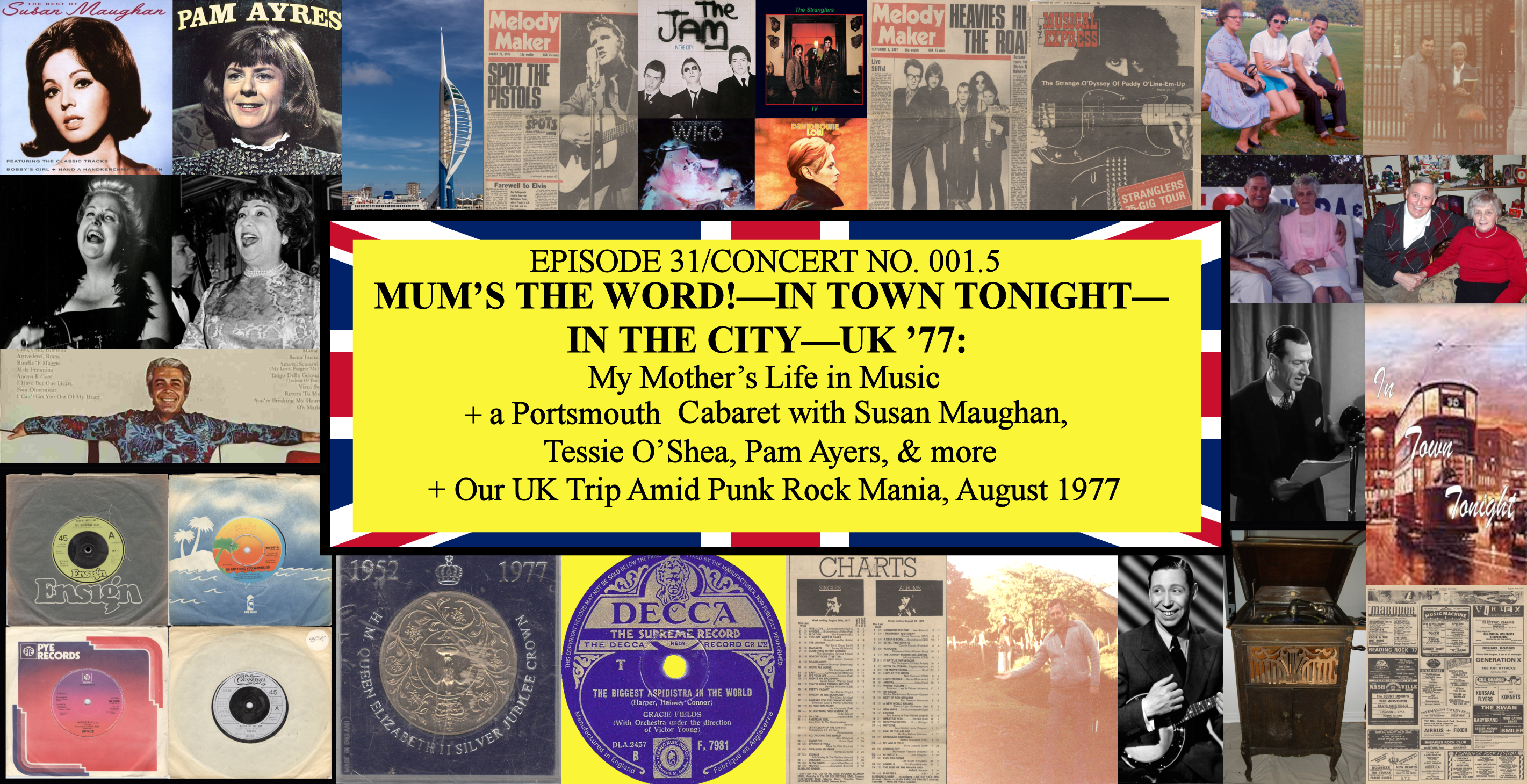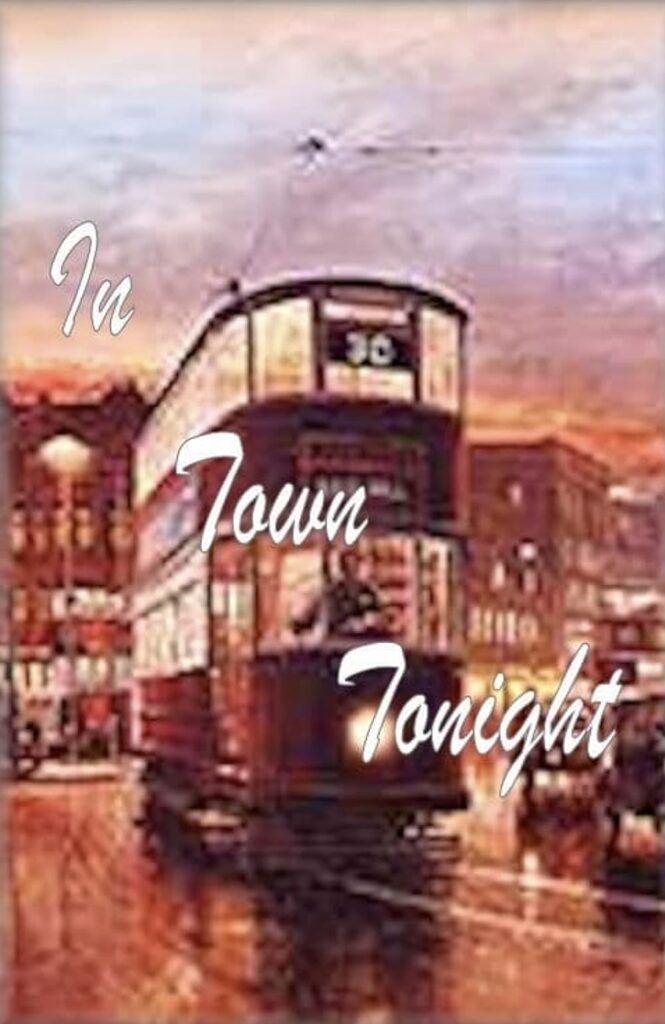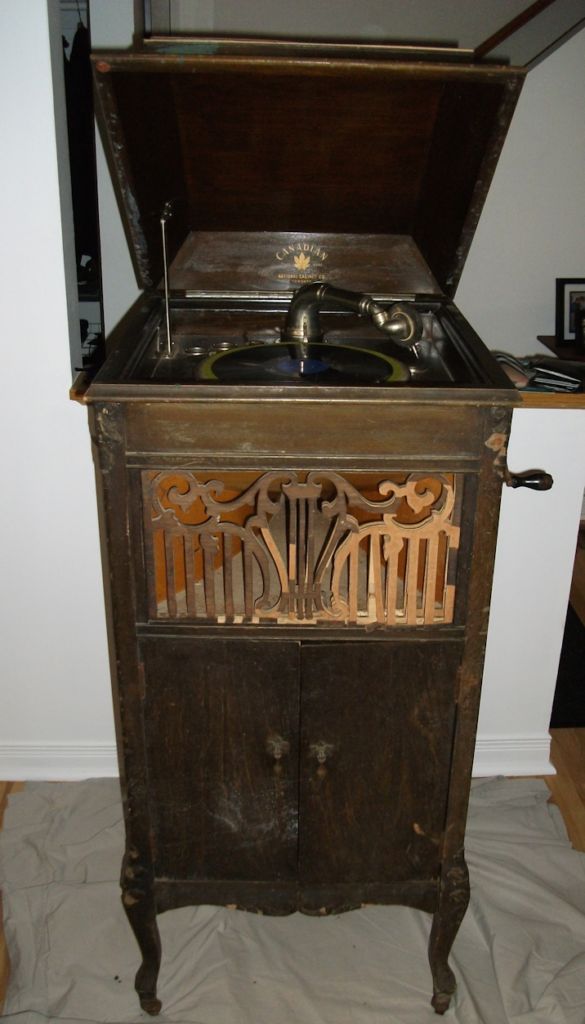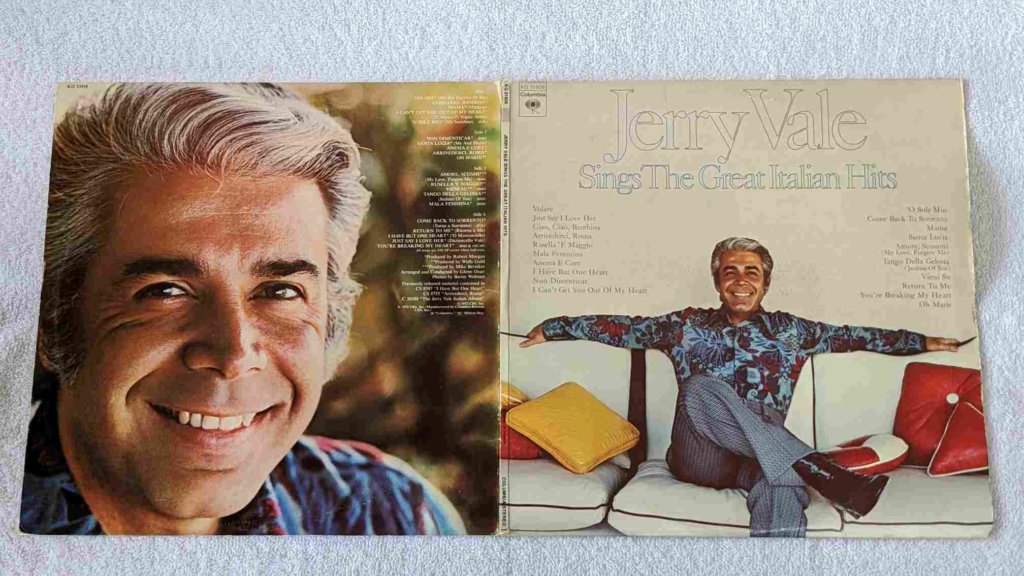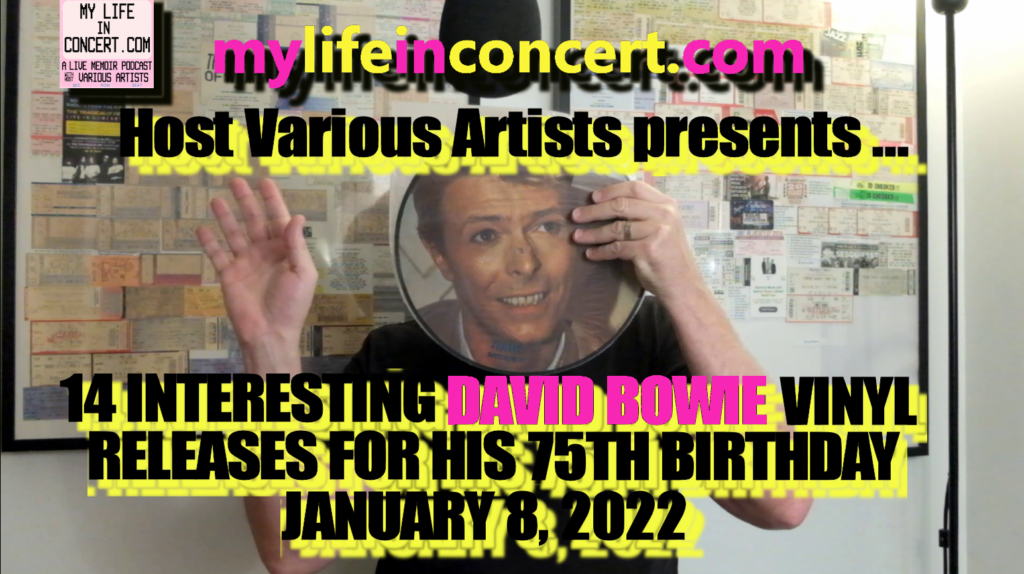With this episode, the series jumps back in time to a cabaret show I saw in Portsmouth, UK, in August 1977 with my parents.
The cabaret took place between my first (Roxy Music at the London Arena, February 8, 1975) and second (Bob Seger at the London Gardens on May 19, 1978) official concerts.
My initial plan was to include it as one of the gigs I will be discussing and writing about in the first of a series of compilation episodes (Coming up as Concert no. 030, High Energy Plan: Etc./Round Up # 1 1983-1985, featuring gigs by 999, The Gun Club, Modern English, and more) that will appear intermittently over the course of this series.
However, I’ve decided that this cabaret was a unique live performance along with being the only one I ever saw with my now 96-year-old mother. Therefore, I am giving this show its own entry. I wanted to take this opportunity to capture not only what she remembers of the event, but also her music-and-technology-related memories from her life growing up in the UK, having been born in December 1926.
Taking in this show with my folks occurred during a three-week trip to the UK. The vacation—my second trip to the Britain following one from childhood, aged 7—could not have possibly been more fortuitous for me.
I had been following punk rock from its 1975-ish NYC inception via the underground press, and then later the British arm of the punk scene through the weeklies (when I could get hold of or afford them) which was absolutely exploding through the UK at the time of my visit. Getting to be there and experience it happening real time was one of the luckiest tunes-y strokes of my life.
So, in this episode, I interview my mother not only about the music she’s enjoyed and seen live, but also about the variety of technologies she has used to hear and enjoy it, starting with her hand-cranked family radiogram in the 1930s through to her love of streaming music today.
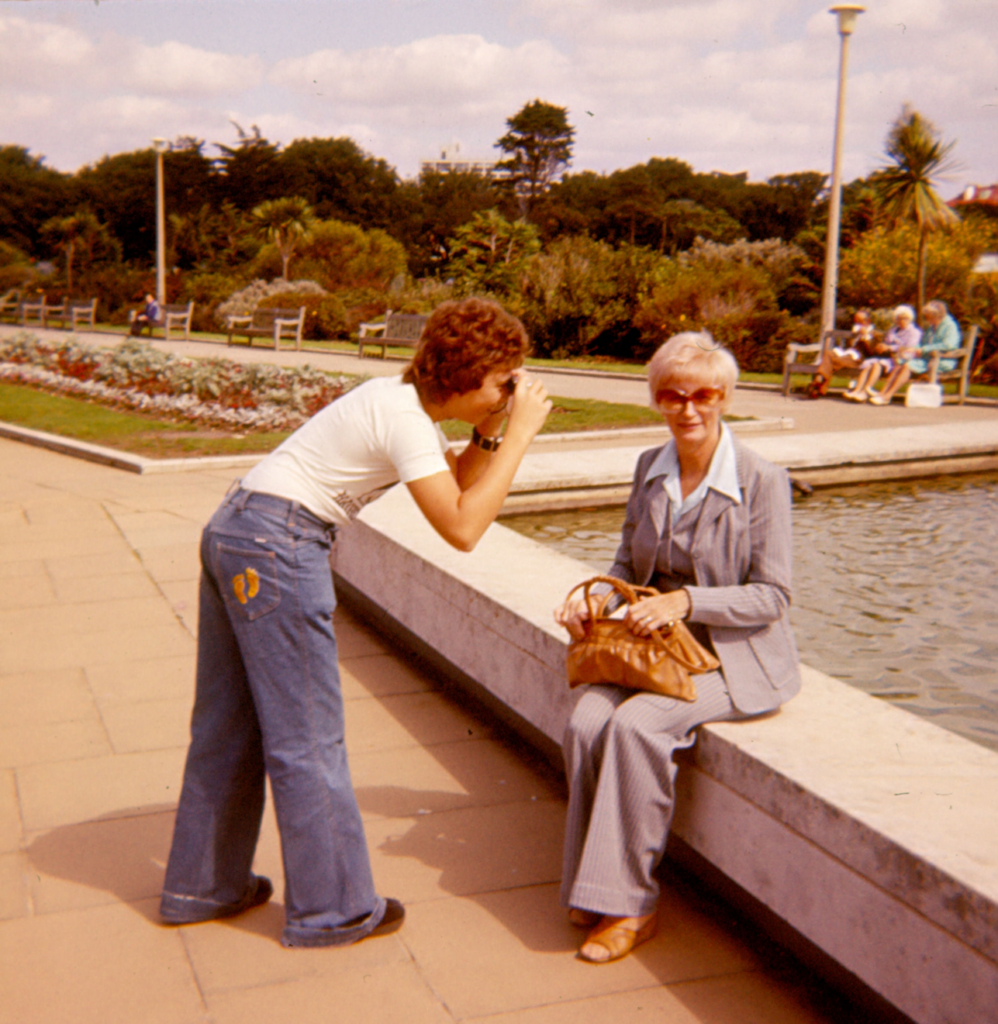
Above: Me taking a picture of my mother in Portsmouth, UK 1977. Torn flares with blue earth shoes and a mop of hair. Welcome to the ’70s!
Below: Conducting the interview, 2023.
All family photos taken by a variety of family members through the decades.
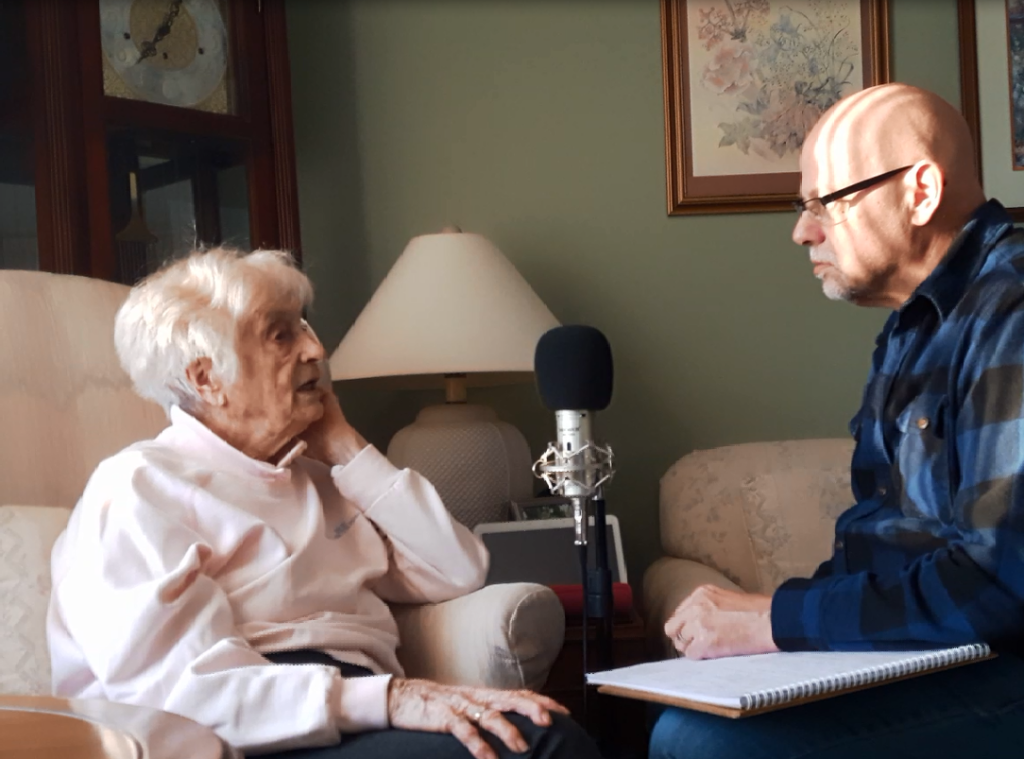
Later on, I turn from looking at my mother’s musical youth to my own experiences, including this live cabaret show we saw in 1977, but even more so about the excitement and impact of being able to spend time in the UK at the peak of punk.
My mother had In Town Tonight. I had In the City. (Listen or read to find out more about all that).
Listen to the podcast to hear the full interview as she talks about the musical journey of her life.
Tune in for Worker’s Playtime, “Attention K-Mart Shoppers!,” The Man in Black, children with acid batteries, revelations at Boots—or was it Woolies?—and what was Ethel Merman really like live?
My mother, Vera, was born into a large family in Petersfield in the south of England in December 1926. Music was frequently played in their house via the radio as well as the family radiogram.
The household radio was wireless and ran off a large battery that would need to be refilled every week with battery acid. Incredibly, it was my mother’s job as a girl to oversee this weekly refilling!
Me: You are now 96. Did you enjoy music when you were younger?
Mum: Well, we did, because … at the weekend, we would always go dancing at the town hall in Petersfield. The music then was more big band music.
Me: But I mean even earlier than that, when you were a child. Was there music on in your household?
Mum: Oh yes, we had a radio.
Me: Right. What kind of radio was that?
Mum: Well, you didn’t plug it in. It ran on batteries. And I’m talking about acid batteries.
Me: And wasn’t it up to you to fill that battery?
Mum: Oh no, you had to take it to a radio shop to get it filled. And that was my job on Mondays. I would take one battery in to have it re-filled, and when I came home for lunch from school, I would pick up a fresh one.
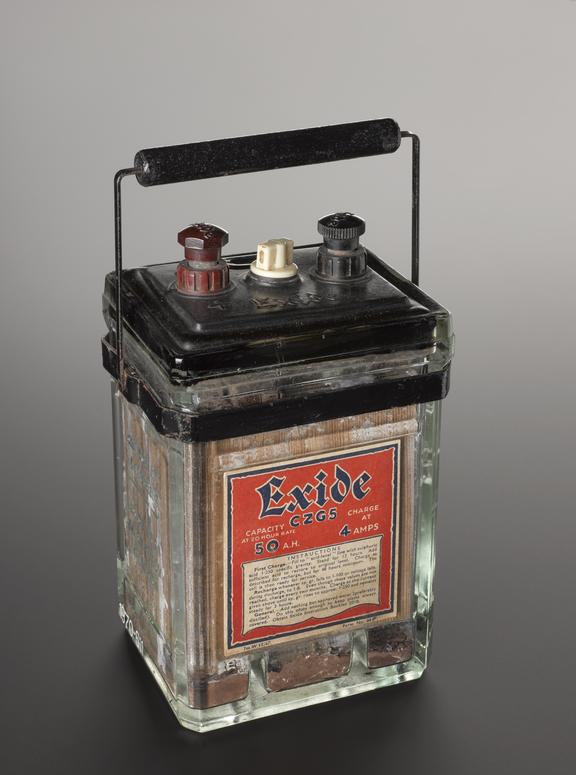
Vintage rechargeable acid battery.
Me: Was it dangerous to carry?
Mum: It was very dangerous. My brother made this box with a leather handle so that the acid didn’t spill. Very dangerous. And you think: a ten-year-old child carrying that.
The big weekly radio broadcast that the family would look forward to was In Town Tonight. It would routinely feature live performance of British and American stars from London. However, this was just one of several popular radio shows of the time.
Me: What kind of music do you remember hearing on the radio? Any programs? Any particular artist?
Mum: Yes. One of the singers was Arthur Tracy, The Street Singer.
Me: Who was he?
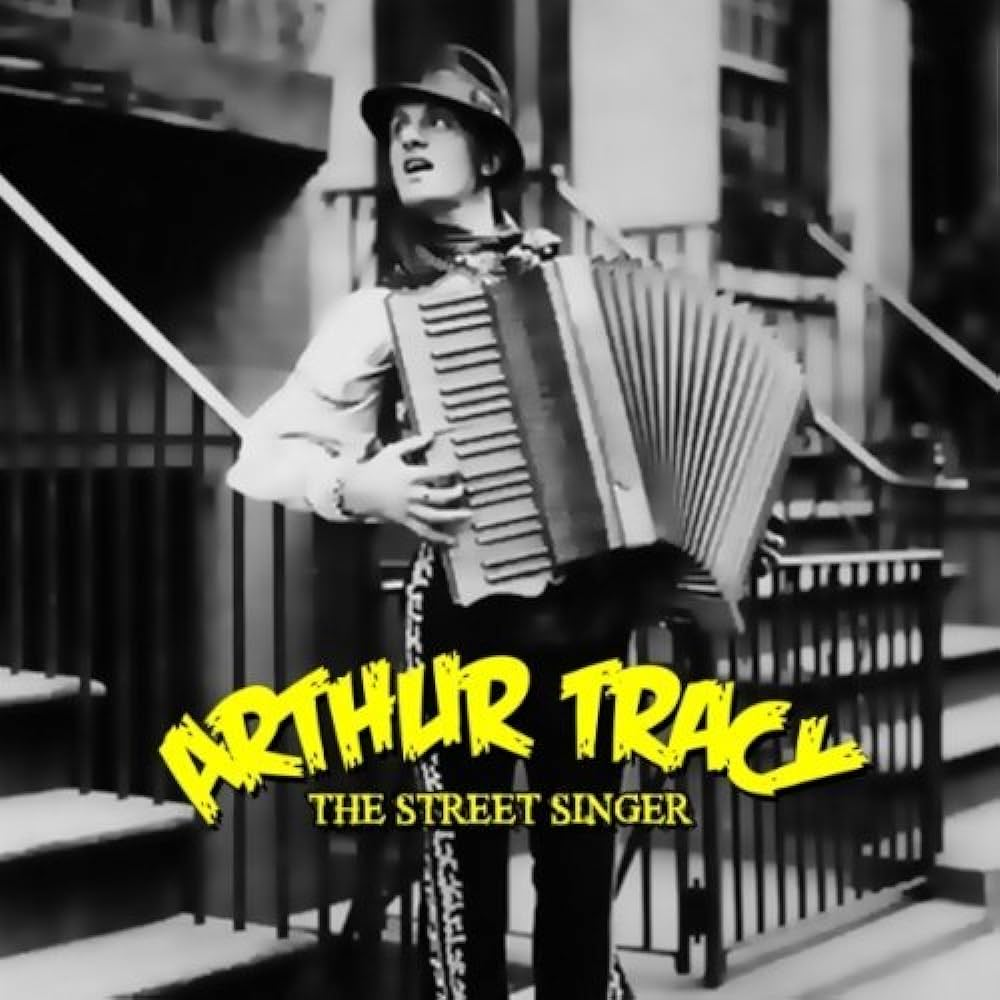
Mum: He was a tenor, and that’s what he was called, Arthur Tracy: The Street Singer. I think he was picked up off the streets, singing, and they put him on the radio. Then there was Gracie Fields.
Me: Yes. Her big song was “The Biggest Aspidistra in the World.”
Mum: Yes. And, then there was …. the guy who played the ukelele …
Me: George Formby.
Mum: Yes. “When I’m Cleaning Windows.”
Me: We just listened to that last week.
Mum: Yes. And I can’t remember too many more … but on Saturday evenings, it was a great night for radio.
Me: Why’s that?
Mum: Because we had (a radio show), it was called In Town Tonight. And then they’d have famous film stars or different guests. And it was on for an hour. And then after that, we’d listen to Valentine Dyall: The Man in Black.
Me: And who was Valentine Dyall?
Mum: He was a detective, and we had a mystery show every week.
Me: Ah.
Above: George Formby and “When I’m Cleaning Windows.” Below: Valentine Dyall: The Man in Black.
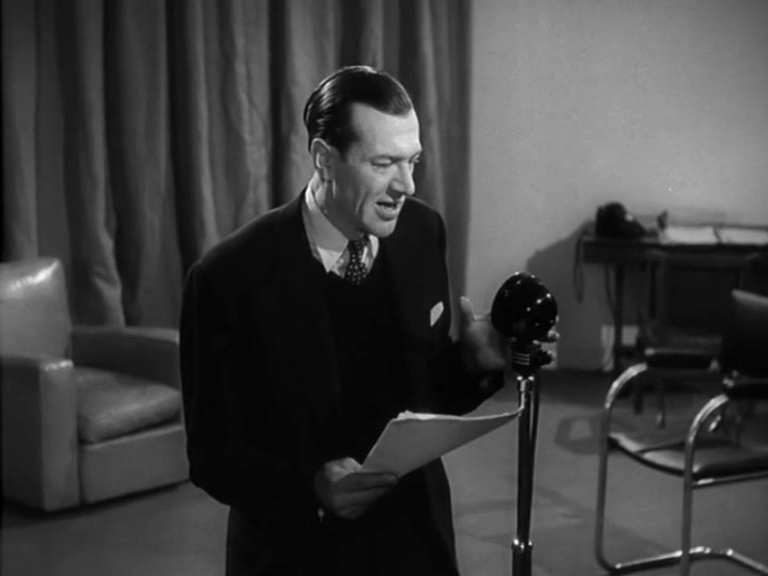
Mum: And then on Sundays, my mother always used to like to sit and listen to the Palm Court Orchestra, with Ann Zeigler and Webster Booth.
Me: Webster Booth and Ann Zeigler: see, you remember all these names.
Mum: Yes.
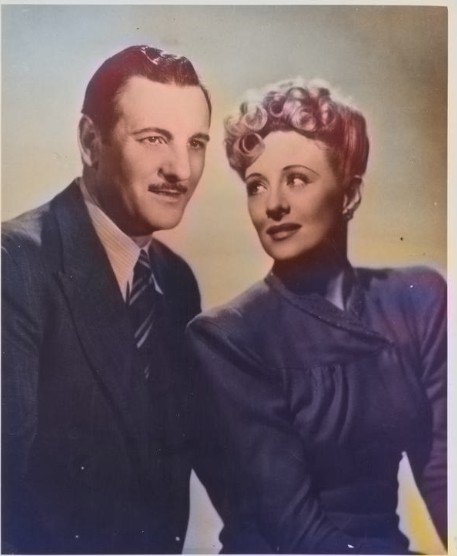
Webster Booth and Ann Zeigler singing “We’ll Gather Lilacs.” My mum has told me that this was one of my father’s favourite songs.
Me: Now in terms of later on, you said that you and dad would go dancing, but what was maybe some of the other music? You were just mentioning something about Julie Andrews was on the radio a lot when she was young.
Mum: This was during the war … and at 12 o’clock from Monday to Friday, it was broadcast from different factories that were making munitions and stuff like that, and she would appear on the program. Not all the time, but I always remember her singing and her beautiful voice.
Me: And how old would she have been at this time.
Mum: 12.
Me: Wow, very young.
Mum: Yes, yes.
Me: And what was the name of the show?
Mum: It was called Worker’s Playtime.
Me: Right. There’s actually a British artist from years later, Billy Bragg, who put out an album using that title, in reference to that program.
Mum: Yes.
The family also had a hand-cranked gramophone and they would listen to the 78s they had in the home.
Me: You were saying that you listened to the radio at home—did you have a record player?
Mum: Yes, we did, which was … how can I put it? It was called a radiogram. It was a piece of furniture.
Me: Right.
Mum: It was vinyl, and you had a needle in (the head of the arm), and you’d go to the record shop and buy a tin of needles.
Me: Did you plug it in or did you crank it?
Mum: Oh no, you wound it up …
Above and below: Cublet’s great-grandfather’s Victrola, dating to the 1920s, which is now ours. My mother’s family’s radiogram from the 1930s would have been a similar piece of technology.
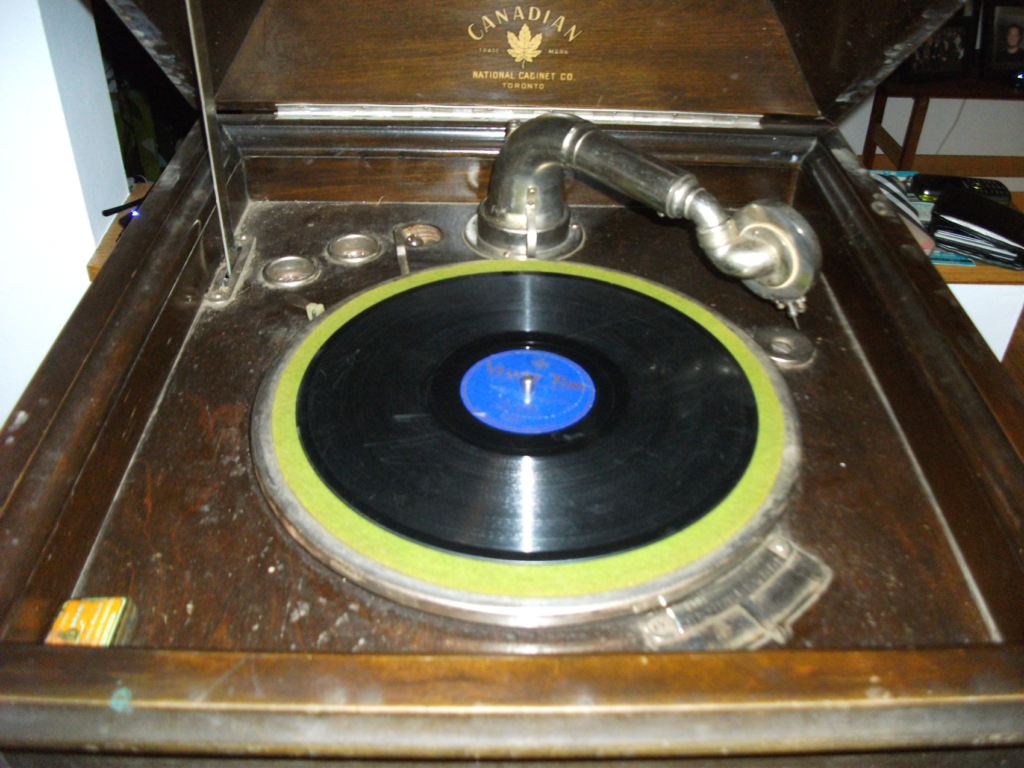
Me: Do you remember any of the records that you had?
Mum: As I told you, we had Gracie Fields and Arthur Tracy: The Street Singer, and the other one was George Formby.
Me: And you had these records?
Mum: Yes.
Me: Oh nice.
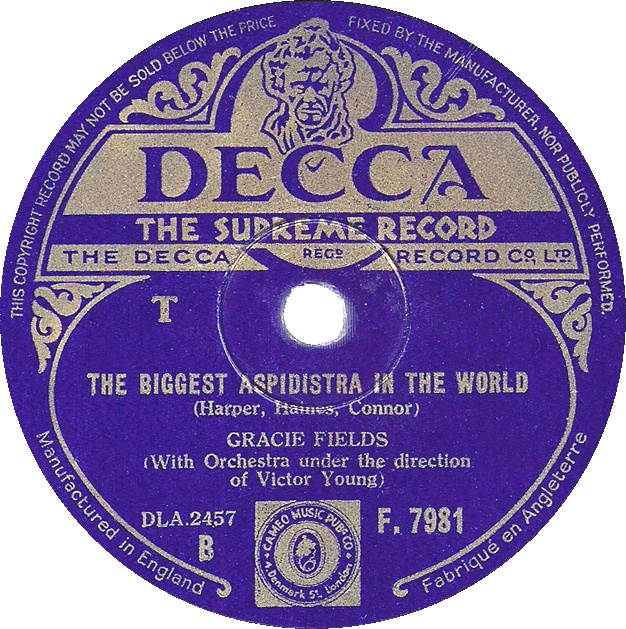
Mum: And I remember the record store that we used to go (to), because there was only the one record store.
Me: What do you remember about the record store?
Mum: Well, it was right on the corner at High Street, in Petersfield.
Me: And did they just have 78s you could go through a look …
Mum: Oh no, the big ones too.
Me: Well, they didn’t have albums till the ‘50s. There were 78s.
MLIC>MUM’S THE WORD!—IN TOWN TONIGHT—IN THE CITY—UK ’77: EP31 PLAYLIST is my companion Spotify playlist for this episode, featuring many of the artists and songs mentioned. It runs the gamut from some of my mother’s favourites from the 1930s through the 1970s and on through many of tracks I heard or purchases I made during the ’77 UK Trip. This is the strangest playlist I’ve ever released for the podcast/blog.
Mum: They were not the great big ones. There were small ones and then ones about that size (NOTE: She must have been remembering the early 1950s). We never had a TV.
Me: That would have been later. I mean, TVs didn’t really start becoming in any way popular, and that’s in America, (until) the late ‘40s, and you were pretty much gone from Britain before they were common.
Mum: No, I saw the Queen’s Wedding.
Me: Right. (NOTE: We are both mistaken: we are both talking about the Queen’s coronation.)
Mum: We went to our friends and they had a television. We saw it on television.
Me: That’s what got televisions popular (in the UK), her coronation in 1953.
Mum: Yes.
Me: But most people—cuz you guys came over in the mid-1950s—most people in Britain in the mid-50s didn’t have a TV.
Mum: No, no.
As she got older, she would see live performances in the larger and nearby Portsmouth.
Me: Did you enjoy music when you were younger?
Mum: Well, we did because … at the weekend we would always go dancing at the town hall in Petersfield. But the music then was more big bands: more band music than what the music is today.
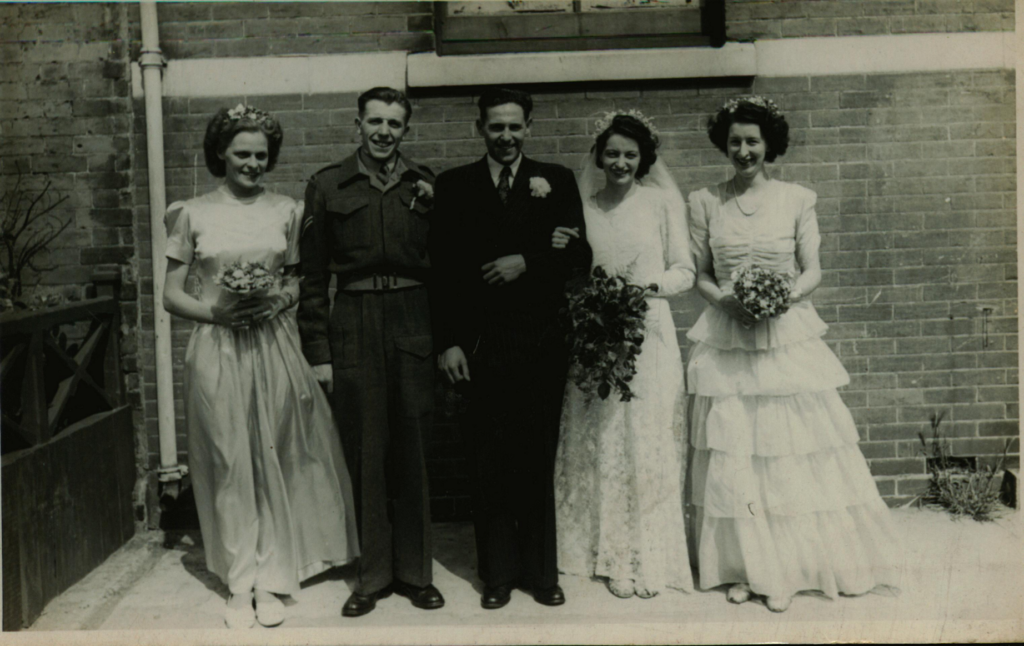
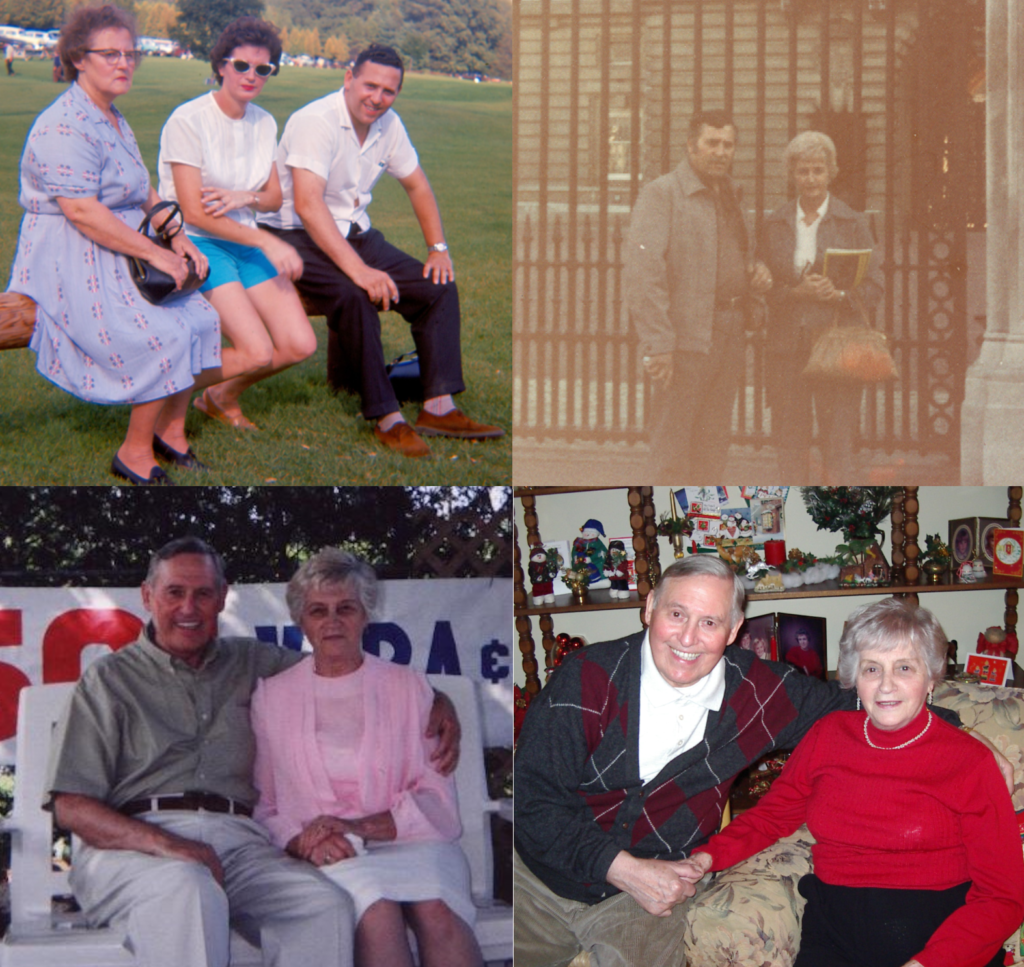
Above: My parents’ wedding, June 1949. Then, my folks—and Gramma—after arriving in Canada in the late 1950s; in front of Liz and Phil’s place, UK 1977; their 50th anniversary, 1999; and in the 2000s.
Below: Extended family photos from through the years …
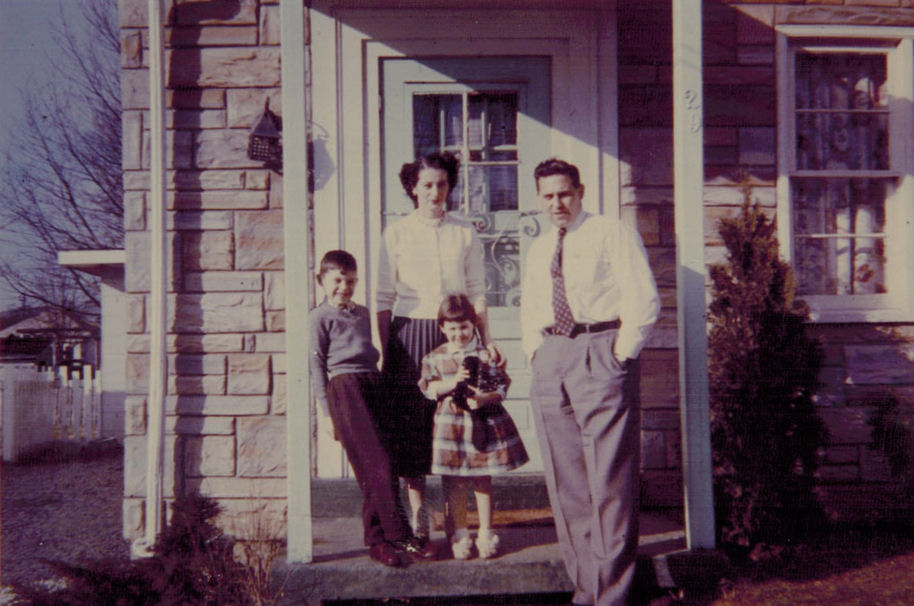
My parents with siblings Paul and Vivien in Chatham after emigrating from the UK, 1950s.
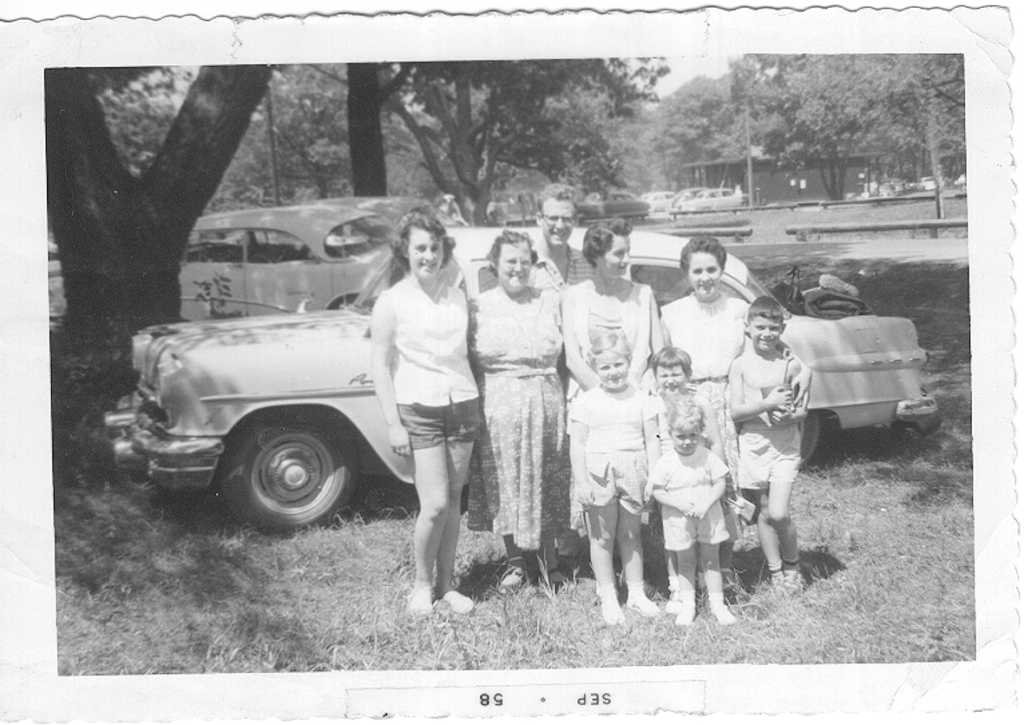
A family picnic from 1958: (Back) Aunty Margaret, Gramma, Uncle Joe, Mum, and Aunty Jean. (Front) Sandra, Vivien, Karen, and Paul.
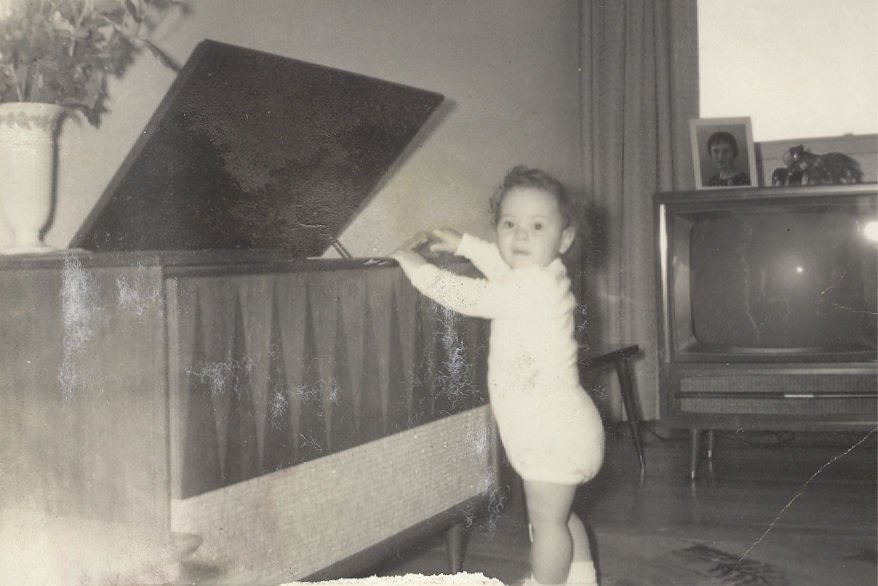
(Above) I have arrived, a born tunehead: Here I am once again trying to get into my Aunt’s Hi-Fi to hear The Beatles, 1-year-old in 1964. It’s incredible how some things just don’t change. (Below) Me in the mid-60s in our backyard wearing a Niagara Falls T-Shirt. The tree behind me is now enormous.

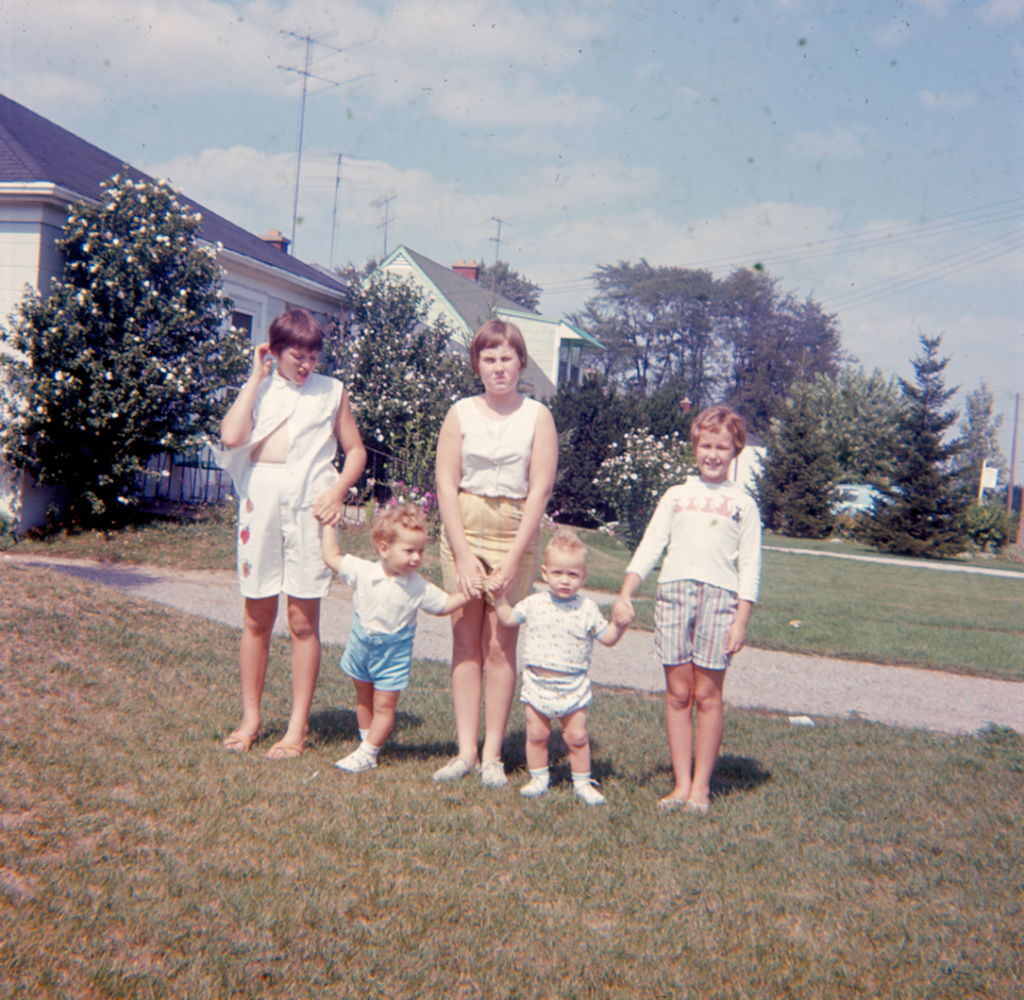
Cousins, Mid-60s, in London: Vivien, me, and cousins Sandra, David, and Karen.
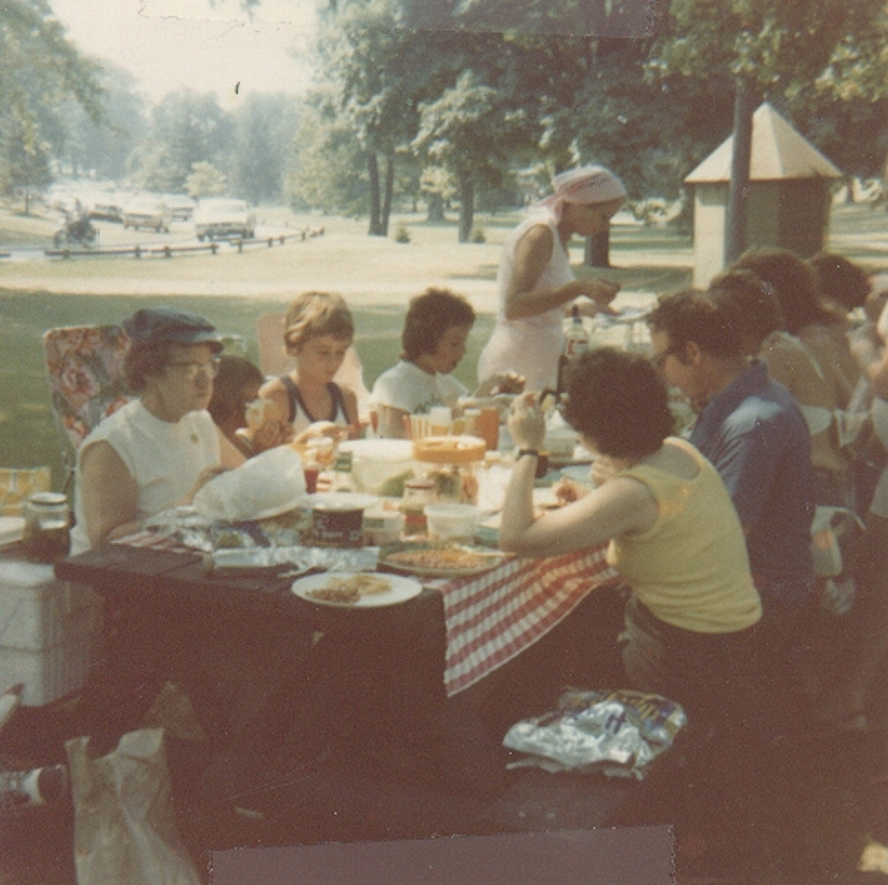
Family Picnic, Mid-70s, at Springbank Park, London, Ontario. Note my Gramma wearing her pure-70s newsboy denim cap. It was a long way from the Staffordshire potteries in Stoke-on-Trent for her.
Me: (What about earlier than that?)
Mum: … In Portsmouth … it was called the Hippodrome … and they used to have all kinds of variety acts there. … The only thing I remember as a child (is) how different actors would come there. We didn’t go there very often because I lived in a little place called Petersfield which was a 20-minute train ride to Portsmouth. And we would go there now and again.
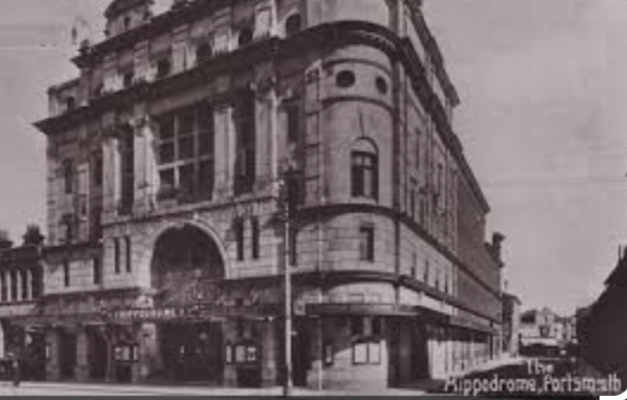
The Portsmouth Hippodrome. It was bombed and destroyed during World War 2 in 1941.
… There was another (place) in Southsea—this is part of Portsmouth—the King’s Theatre, and they would have all different kinds of plays there.
Me: Did you see something at the King’s Theatre?
Mum: Yes, we did. Ethel Merman.
Me: You saw her there?
Mum: Yes.
Me: What was she like?
Mum: Very loud.
Me: Do you remember who else you saw there?
Mum: I can’t, cuz I’m 96 and my memory is not what it used to be.
Me: It’s still very good. Now, I remember … I think it was you told me, or dad told me, that before he came over to Canada, to start the emigration process, you and dad saw Kiss Me Kate in 3D. And it was at one of those two places.
Mum: That was at Southsea … in one of the cinemas. And it was really good, because when they were throwing things, it felt like they were throwing it at you.
Me: Right. I’ve seen that movie. I love that movie.
My dad emigrated to Canada in 1955, with my mother, brother and sister following the next year. Sadly, my dad, Ernie, passed away in 2018 so I can’t interview him about any of this. However, I clearly remember his telling me in the ‘70s about seeing Bo Diddley in Toronto in the mid-50s, shortly after landing here.
To say that I was impressed to hear this is an understatement, however, my dad was less enthused about the performance.
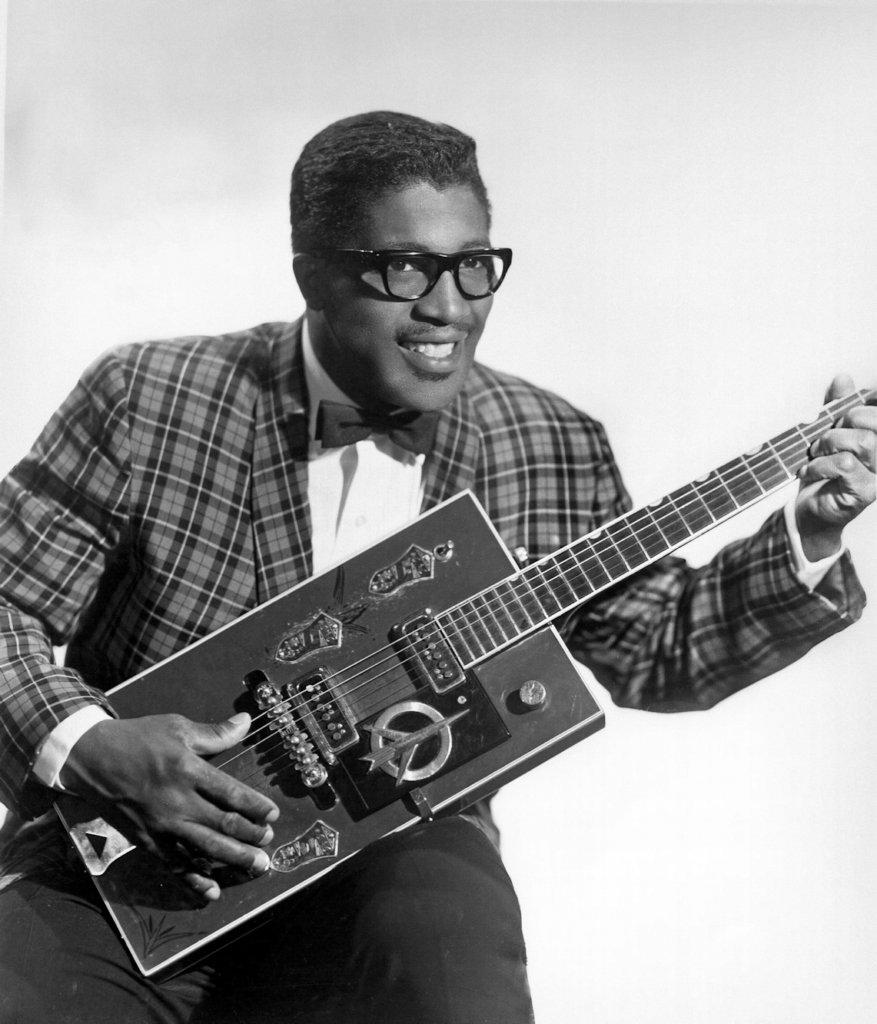
The Great Bo Diddley in 1957. Dad: “Bloody load of noise!”
His review went something like this: “Bloody load of noise! The band was so loud and amplified that I couldn’t hear any of the bloody words he was singing!”
Oh well.
They started settling in here in Canada, first in Toronto, then Chatham, and finally in London in 1960. While they were living in Chatham and joined by my uncle’s family, my newly-emigrated Aunty Jean was in a community theatre group there with Sylvia Fricker, later Sylvia Tyson of Ian and Sylvia fame. She also sometimes babysat my cousins and older siblings.
Canadian folk legends Ian and Sylvia. Sylvia was born Sylvia Fricker, wrote the classic “You Were On My Mind,” and was a sometime babysitter for my family in Chatham, Ontario in the late ’50s.
At some point in the early ‘60s in London, they bought their first record player. It was monaural and was replaced at Christmas 1968 by a single unit stereo player with a tall spindle for stacking multiple albums.
Very au courant at the time.
Family Stereo Systems of the 70s
We’ve got Stereo! The first family stereo from 1968-1972. (Below)
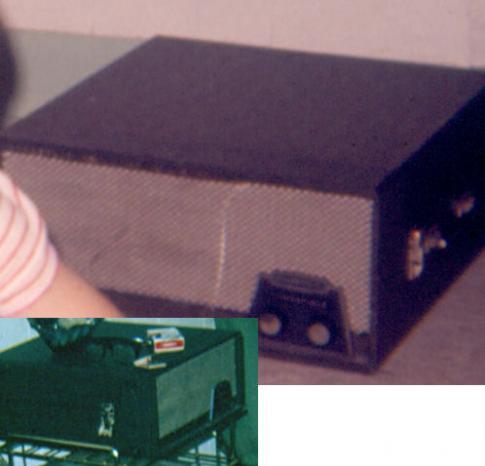
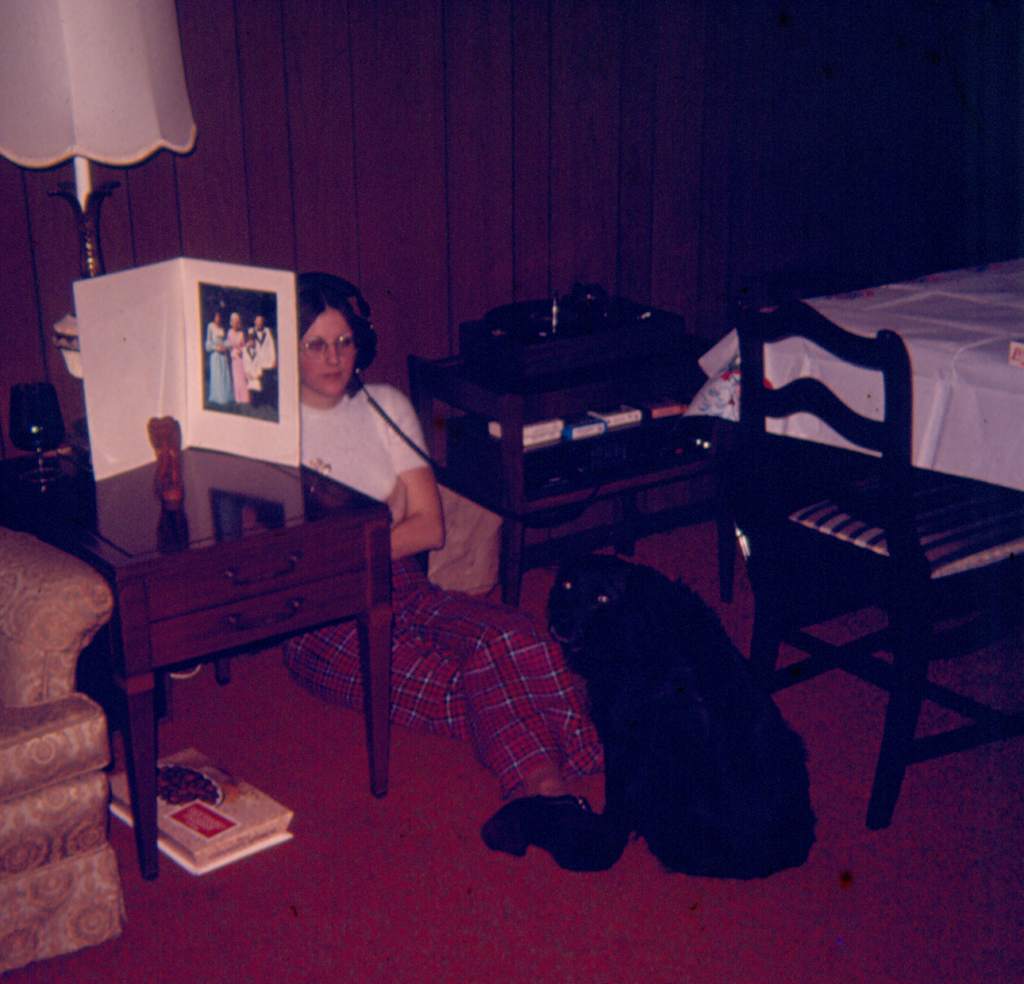
(Above) My sister Vivien and the family dog, the one and only Peter Moochings, Xmas 1972. My sister listens to her new copy of Elton John’s Madman Across the Water under the headphones through our component set that we got circa 1971-72. Note 8-Tracks. Also note—as mentioned in the podcast—the red and gold shag rug, wood panelling, and my sister’s flared pants and platform shoes. Swag lamp not pictured.
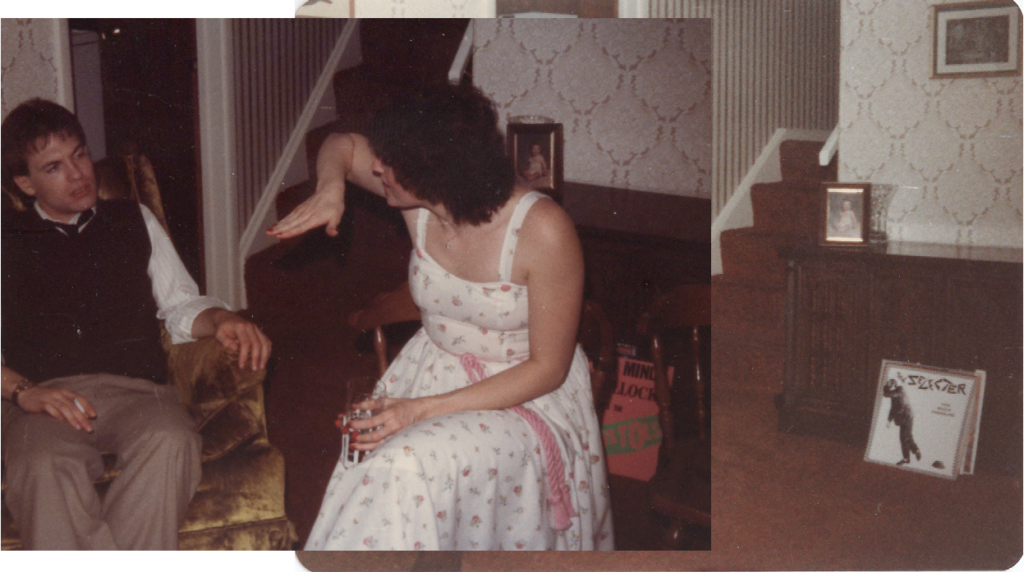
(Above) My parents bought the record player with 8-track furniture unit in 1975. Here is my brother-in-law Rick aka Sparky with Vivien in 1980. Note my copies of (a) Never Mind the Bollocks Here’s the Sex Pistols in the first shot and (b) The Selecter’s Too Much Pressure in the second. A closer look below reveals that behind it are The Gang of Four‘s Entertainment, PiL’s Second Edition, and The Undertones’ Hypnotized. Standard listening fare for me at the time.
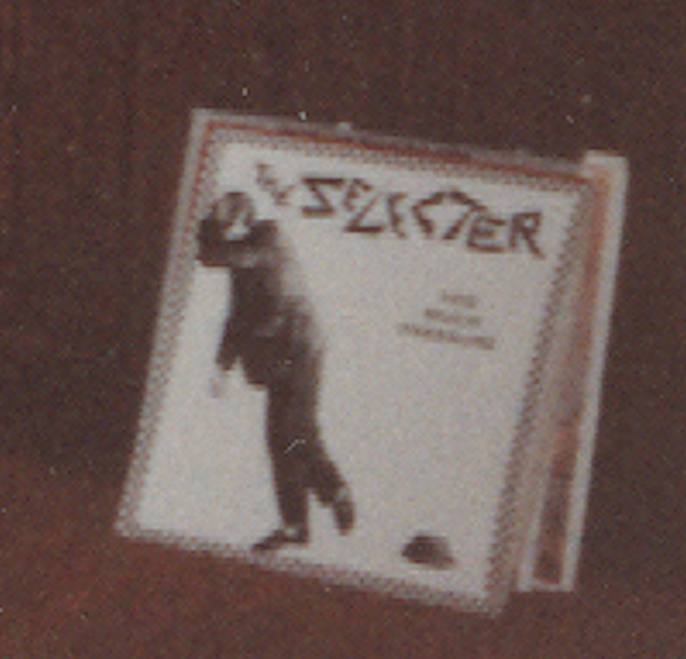
We had stereo now! Trust me, it was a big thing. And just in time to listen to my brother’s then-recent LP acquisitions: The Beatles’ White Album, The Rolling Stones’ Beggar’s Banquet, and The Jimi Hendrix Experience’s Electric Ladyland.
Our next big sonic upgrade was a component set with an 8-track player and a receiver with speakers circa ’71. A turntable was finally added shortly thereafter.
I seem to recall my folks buying plenty of 8-Tracks in the ’70s, with my mother playing them a lot as she didn’t have to keep changing the sides.
They also had had plenty of vinyl as well. As with most parents/children from that time—especially with me as I came along a lot later and my folks had me in their mid-30s, a bit unusual in the early ‘60s—there was a massive culture gap between what music they listened to and what we listened to. A lot of the vintage pre-rock pop they so beloved (and most of which I now love as well) sounded like muzak to me at the time. They also liked the swing music of their youth as well as opera, classical, easy listening music, the odd radio pop hit, and country.
Then as now, my mother particularly likes Glen Campbell, who we also both agree on.
Me: So in terms of coming here (to Canada), what are some of the artists you like from later on? I know you really like Glen Campbell. What are some other singers that you like?
Mum: Well one, and he was English, (is) Russell Watson. I’ve got his CD. … I really liked him … And of course I like the Three Tenors.
Me: I know you love the Three Tenors!
Mum: Yes.
Me: The videos and the CDs.
Mum: Right. … I can’t say that I really had a … preference for one singer. I used to like all kinds of music. I don’t like all the music today …
Me: Well, you hated everything we listened to.
Mum: That’s right! … I like listening to the music of the ‘40s, ‘50s, and ‘60s.
Me: Admittedly, you didn’t like what we played—(but) you kind of drove us up the wall too. The one I remember that drove me crazy that you used to put on, and it was a double, was Jerry Vale Sings the Great Italian Hits.
My nemesis: my mother’s well-played copy of Jerry Vale Sings The Great Italian Hits (1972). (Photo by Colin Heddle)
Mum: Oh, yes. I like Jerry Vale. Very nice.
Me: I know you loved Engelbert Humperdinck … You like Dolly Parton too.
Mum: Oh yes, I like Dolly.
However, most of the time, it was my sister and I who monopolized the stereo. When my parents got their Hi-Fi furniture set in 1975, my sister got the old stereo and I got the family set largely to myself.
Sunday morning/early afternoon is when my parents took over the stereo system, with my mother routinely blaring records or 8-tracks throughout our home while she did the big Sunday full-house thorough cleaning.
Being the smartass I was and sometimes still am, I would do things like pull back on the lever that would lift the needle and arm off the record and then yell through the house: “Attention K-mart Shoppers! Attention K-mart Shoppers! There is a Blue Light special in the ladies department, and for the next 15 minutes, all lingerie will be 30% off. Watch for the Blue Light special and thank you for shopping at K-mart!” before pulling the lever back for the needle to resume from where it left off.
I would then here a snarky and grumpy “Veeeery funnyyyy” emanating from one of the bedrooms upstairs.
As mentioned during the interview, most of what we listened to drove my parents up the wall. Also, my mother often got the names of our favourite acts wrong. Bryan Ferry and Suzi Quatro were Bryan Ferris and Suzi Quattral to mum.
Although she did get “Bloody Mick Jagger!” correct.
However, with the mid-70s fading of glam and the rise of more middle-of-the-road rock (the new easy listening), I think my folks were a bit relieved that we were listening to music that was a bit more quieter.
If they only knew what was sonically just around the corner.
Punk rock eventually reared its head, ending mid-70s mellow with a “bloody racket.”
As I have discussed in past episodes and entries such as EP 7 on Bob Seger and Concert no. 186 on Blondie, I had been following the New York City punk scene since its inception via the pages of Rock Scene magazine. I did get to hear Patti Smith in 1975, but otherwise, it wasn’t until 1977 that I finally got to hear the other punk groups. By that point, what had begun in NYC in 1974-75 had crossed the ocean in 1976 and positively exploded in the UK as a very real commercial and social force.
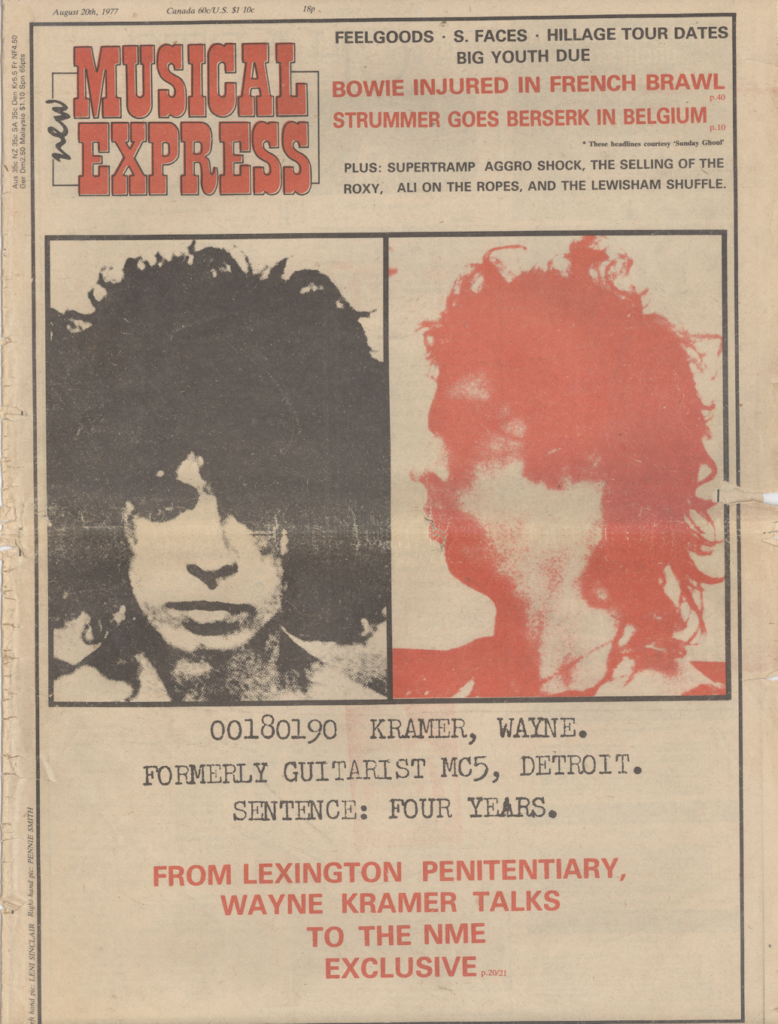
NME August 20, 1977: The MC5’s then-imprisoned Wayne Kramer was on the cover. (Below) The UK Top 30 Albums and Singles from this issue. This is what was on the charts upon my arrival in mid-August. (Further Below) Two Spotify playlists that I’ve compiled counting down each chart: MLIC>NME Top 30 45s + 4 Bubbling Under, August 20, 1977 (34 to No. 1) and MLIC>NME Top 30 LPs + 3 Bubbling Under, August 20, 1977 (34 to No. 1). Bootsy Collins’ “Pinocchio Theory” was one of the Bubbling Under 45s: in 2011, he personally headbutted me at Ottawa Bluesfest (see video).
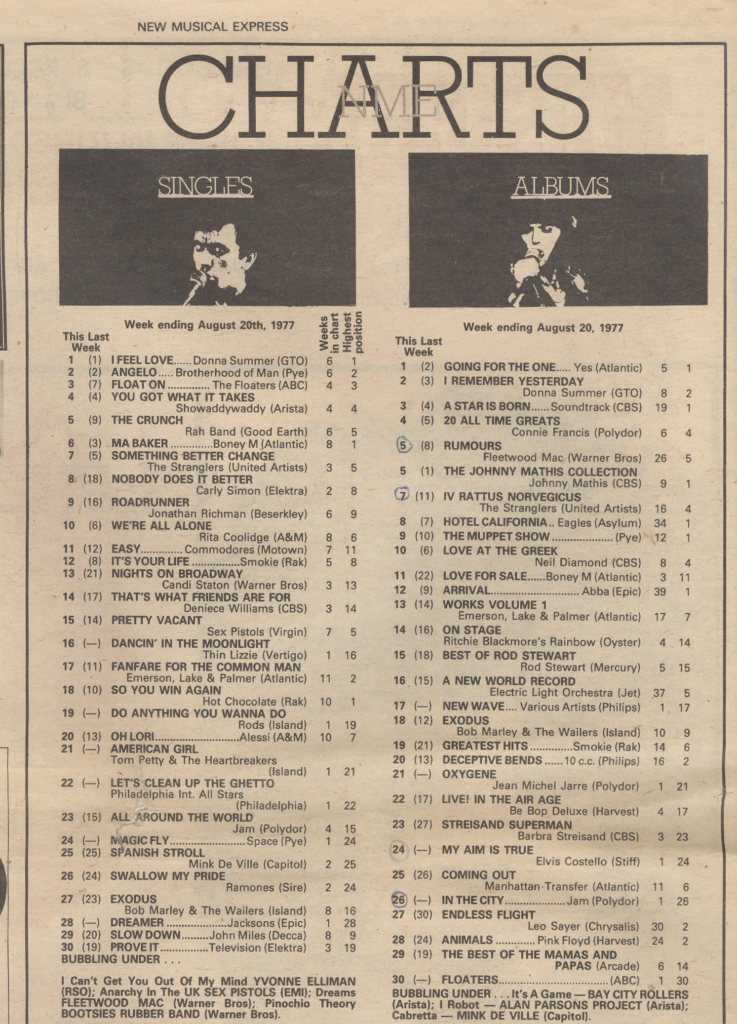
For that 75-77 period, and of course beyond, I devoured Anything that had to do with US or UK punk rock (meanwhile, Toronto’s own scene had started in the city and Hamilton at approximately the same time, but I wouldn’t really start hearing about that until ’77.)
So, when my parents announced in 1976 that we were heading back to the UK in 1977—the Queen’s Silver Jubilee year—I felt like I had won the music-experience jackpot, especially once the year had started and I was reading about punk-mania in the UK. I still feel that way. A safety-pinned Lady Luck with green hair was very much with me at that time.
The big excitement for my 14-year-old self when I touched down was that the Sex Pistols were embarking on a “secret” tour of the UK: “secret” because they had been banned from playing in almost every venue in the country.
Instead, they were playing under assumed names, with word-of-mouth packing out the venues. Here’s an article from Melody Maker about the tour, focusing on this gig by the rather-cleverly named The Spots (aka Sex Pistols On Tour Secretly + Spots = zits in the UK, har har).
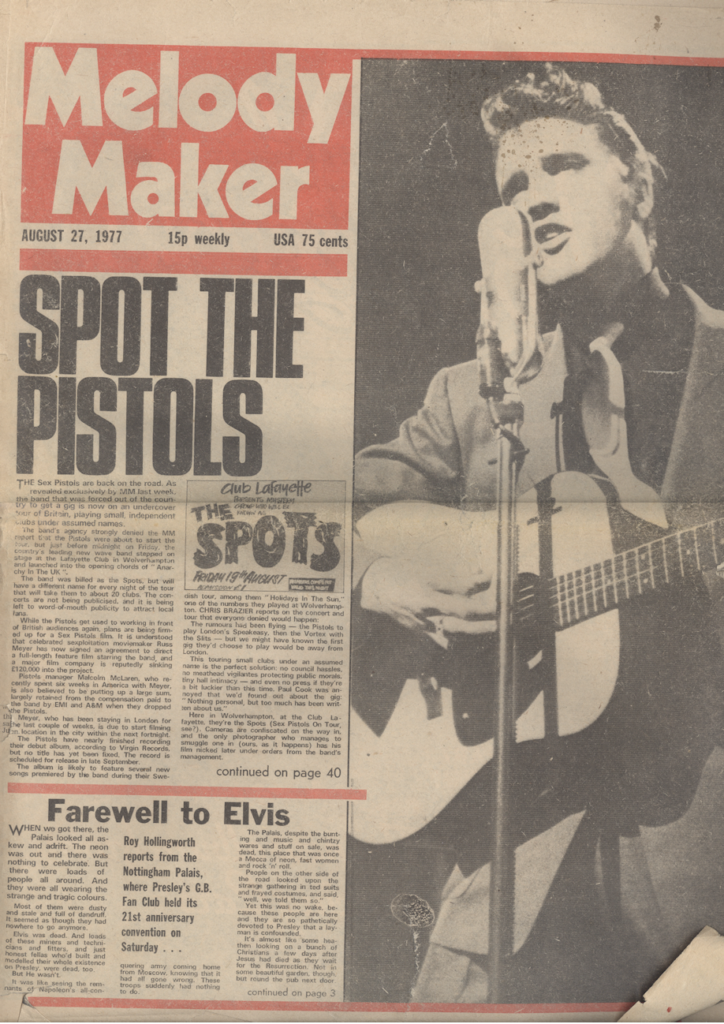
Above: Melody Maker reports on the death of Elvis and the Sex Pistols secret tour of the UK. Below: Detail of the Sex Pistols article and the video for “Pretty Vacant”: their third single which was in the charts when I arrived. It was the follow-up to their classic, explosive “God Save the Queen” hit earlier in the summer. (Scans by VA)
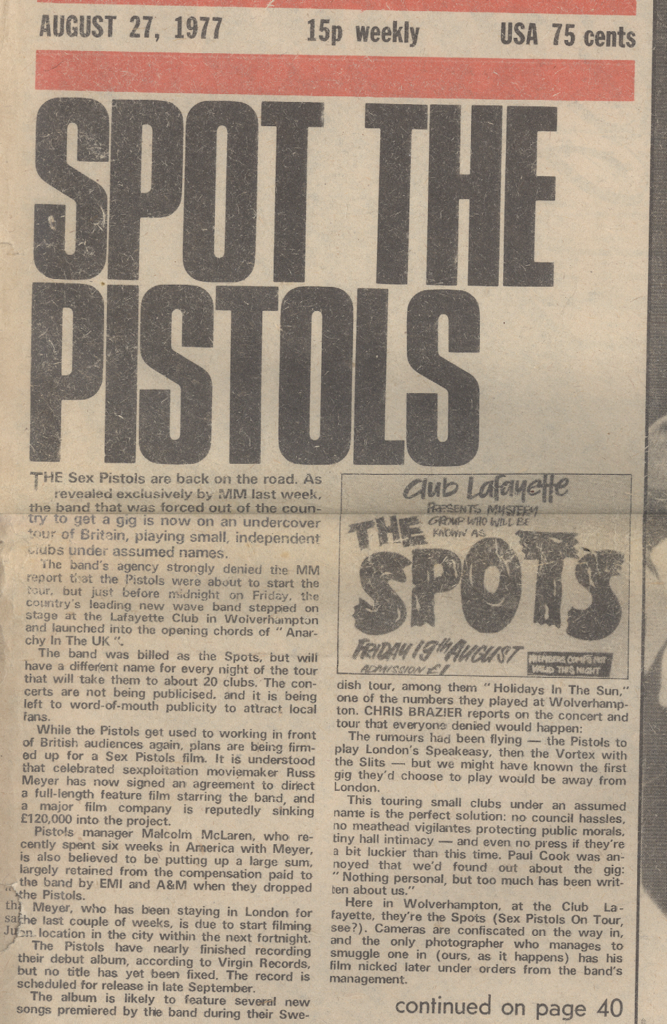
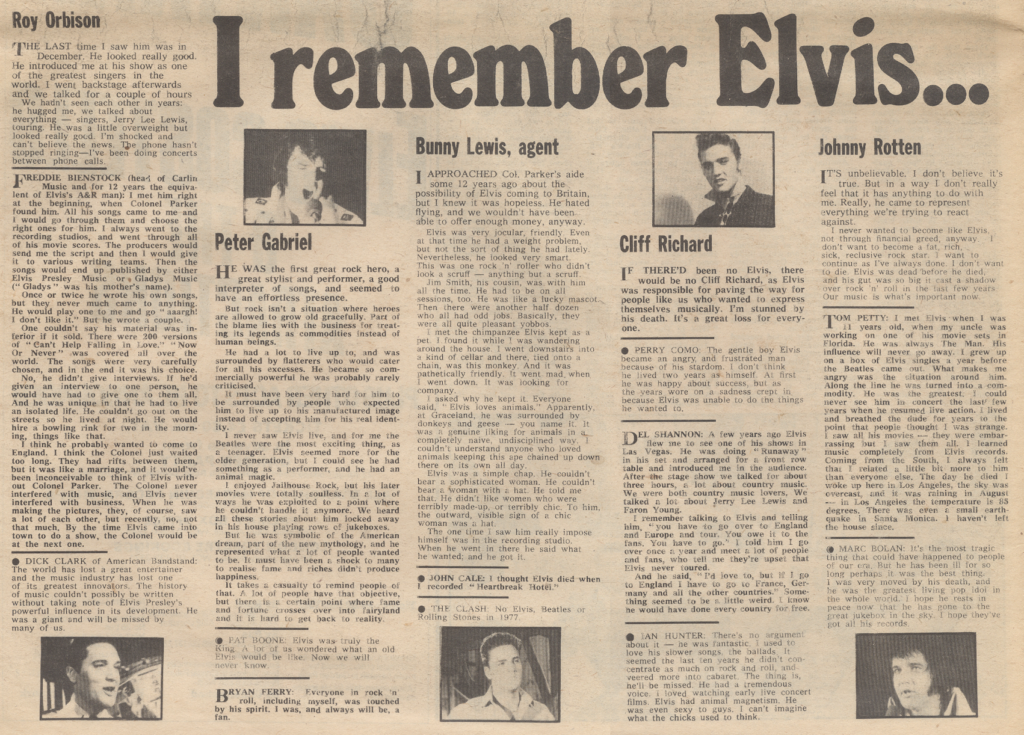
(Above) Marc Bolan commented re: Elvis’ death, “It’s the most tragic thing that could have happened to people of our era” in a star-studded “I Remember Elvis” article. Three weeks later, Bolan himself was dead from a car crash (below).
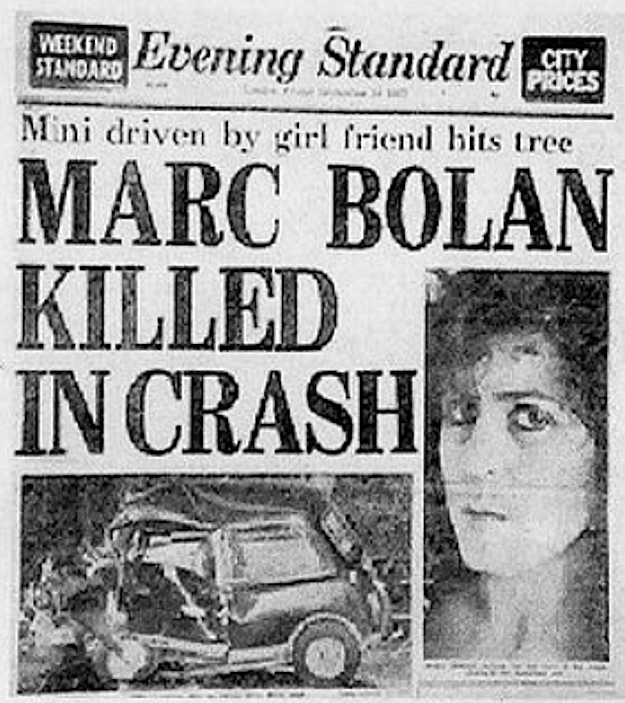
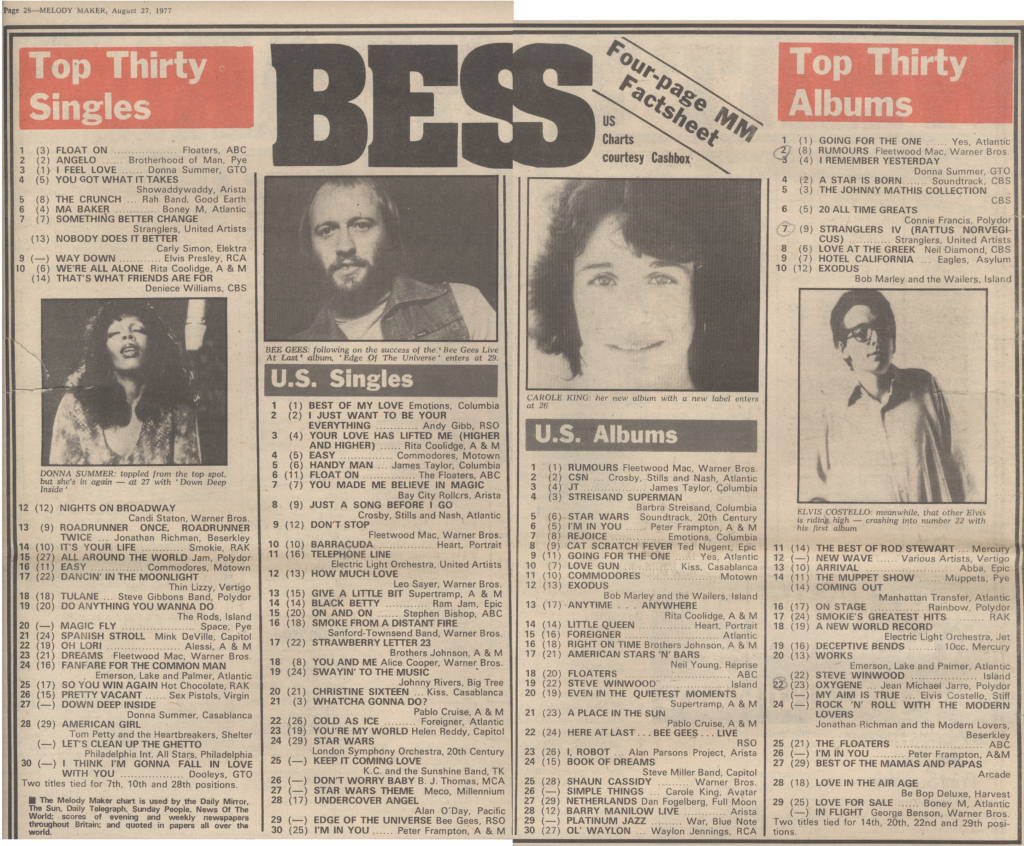
Melody Maker’s UK/US charts for August 27, 1977.
I certainly wanted to see them but knew that wasn’t going to happen (Dad: “You’re not bloody well going to see the bloody Sex Pistols!”).
Instead, I got to see this cabaret performance with pre-Beatles Brit Pop Songstress Susan Maughan—and possibly the legendary Tessie O’Shea.
Neither of us know for sure where we saw this show. My mother believed that we saw it at the Portsmouth Hippodrome. Unfortunately, that a mis-memory as the Hippodrome was bombed in the war in 1941.
Here is what else we remember from that night:
Me: There was someone else on the bill as well (besides Susan Maughan, Pam Ayres, and the Famous People Players) … but I can’t remember who it was.
Mum: I think (it was) Tessie O’Shea. Two-ton Tessie O’Shea.
Me: I know who Tessie O’Shea is.
Mum: Yes, I am sure she was (on the bill).
Me: Hmm. I guess I’ve forgotten. On one hand, I am thinking that I (would) have remembered, but then would I have known who Tessie O’Shea was then? I know who she is now.
Mum: They had lots of comedians on too …
Me: I remember Pam Ayres being really funny.
Mum: Oh yes. Actually, her dialogue was more like poems.
Me: Yes!
Mum: She would read it more like poems.
Me: And I remember you bought a book of her poetry.
Mum: Yes …
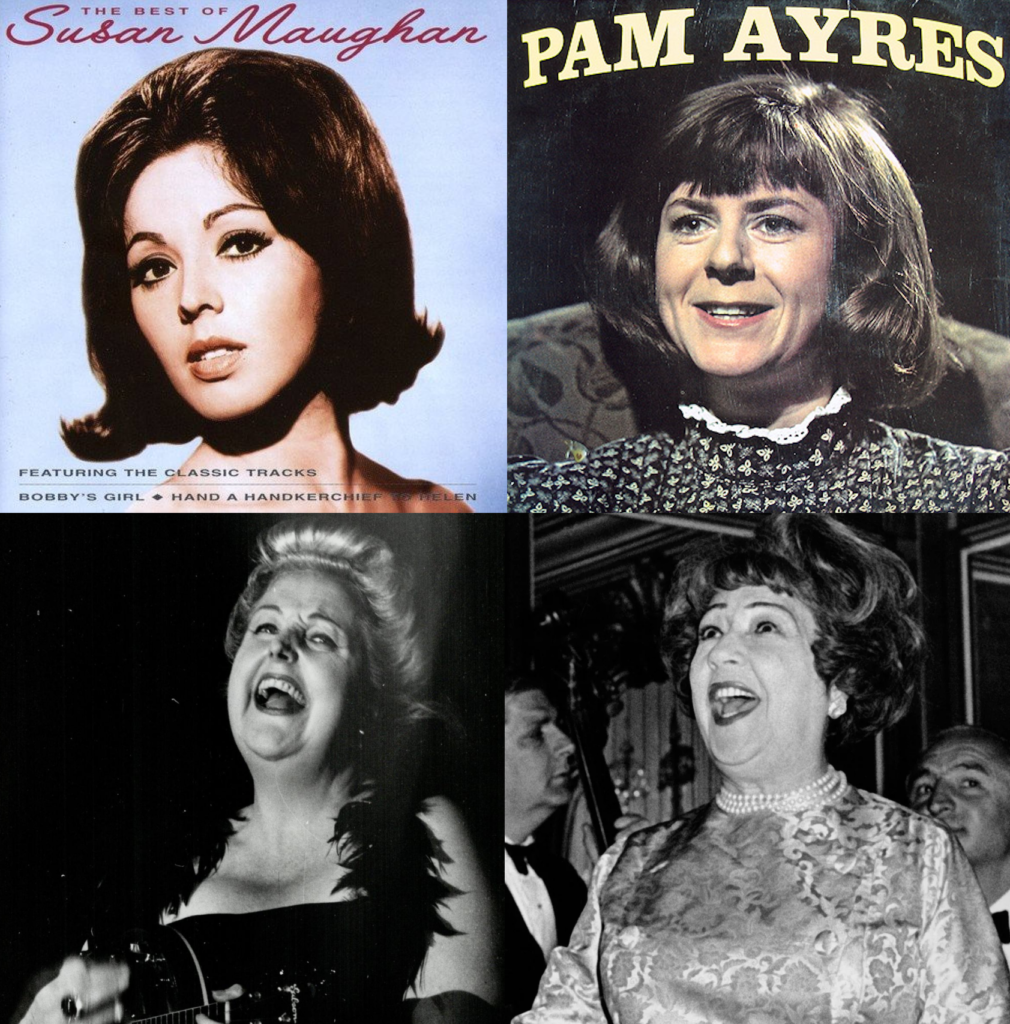
Live in Portsmouth (clockwise from top left): Susan Maughan, Pam Ayres, Ethel Merman, and Tessie O’Shea.
Below: A commercial for Ayers’ 1977 UK TV variety series, The World of Pam Ayres. Yep, it was the 70s. Her poems were quite funny and clever, though.
Me: Now this isn’t who I wanted to go see, because there was an act touring England who I wanted to go see. That was the Sex Pistols.
Mum: Oh yes.
Me: Dad said “No” to that one. But I did enjoy Susan Maughan.
So, while Susan may not have been the Sex Pistols, I enjoyed her thoroughly nonetheless. And of course she did her signature hit, “Bobby’s Girl.” That one I recognized.
I am pretty sure another performer was on the bill that I can’t remember and so I am going with my mother’s memory here that it might have been Tessie O’Shea. She was such an iconic music-hall performer in the UK that I truly wish I could remember her performance.
Thanks for the memories and interview, Mum!
As for the rest of the trip itself, it was splendiferous from a variety of standpoints, but I am going to concentrate on the musical aspects.
My mother had In Town Tonight; I had In the City by The Jam.
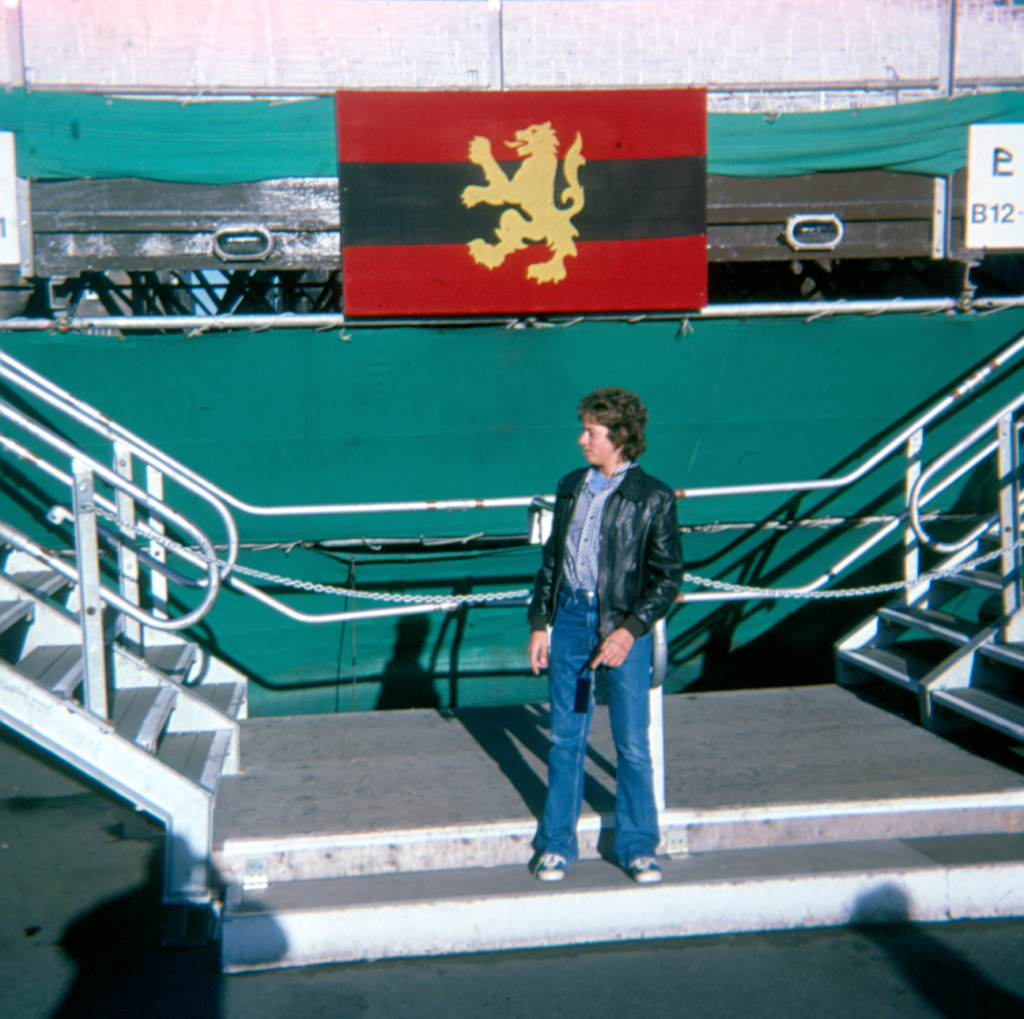
(Above) Me at Edinburgh Castle, Scotland, proudly sporting my newly purchased leather bomber jacket. Moments later, I was almost run over by a car. (Below) My coin for the Queen’s silver jubilee.
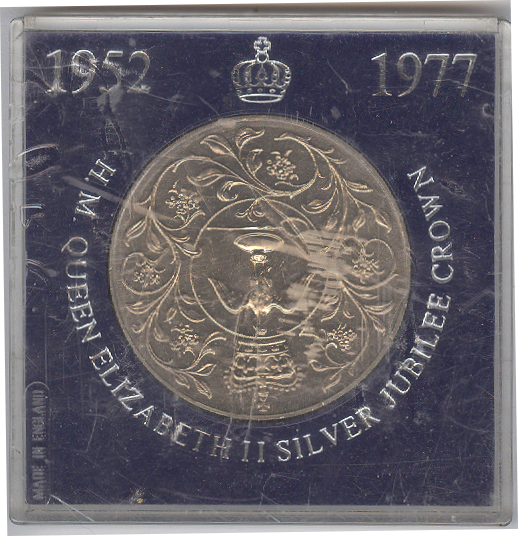
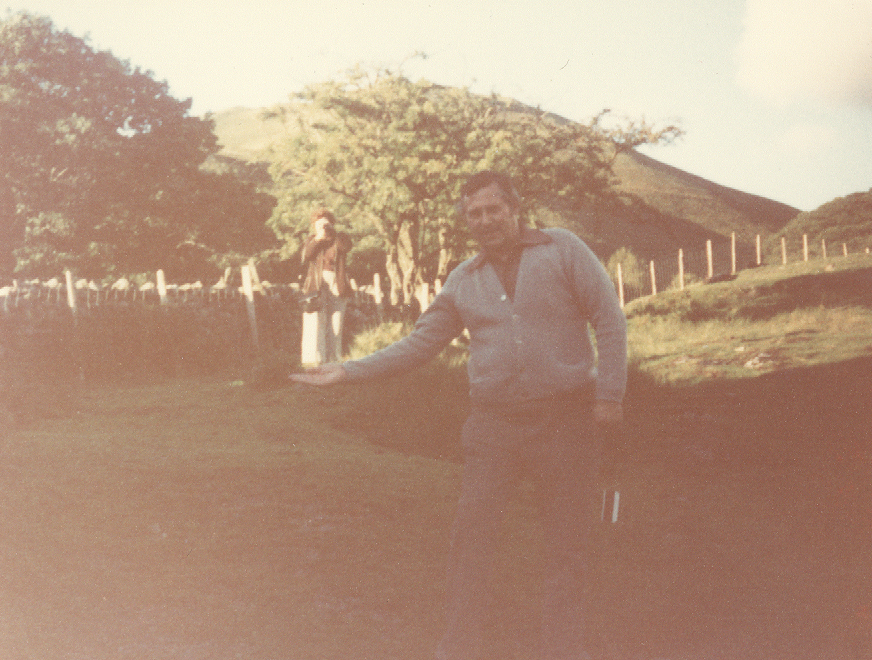
Crazy Cumbrian Capers: My dad and Aunt Mary getting up to hijinks and tomfoolery in the countryside of Cumbria in North UK at my urging. My Aunt is filming me back.
First, the trip was eerily bracketed by the deaths of two iconic musicians. Elvis Presley died the day before we flew into Gatwick. I clearly remember sitting in the car with my dad, stuck in late-afternoon rush hour traffic on Highbury heading north near Huron on a steamy August day here in London, Ontario, with the windows down in our un-air-conditioned car, when the shocking news came over the radio.
In the UK—with a greater overall passion for music than on this side of the pond, at least then anyway—the country went nuts over his passing. From the moment I touched down, Presley’s new single, “Way Down,” was absolutely ubiquitous. In the wake of his passing, his albums were heavily racked everyone, a practice that also became common with passing stars and legends.
Within weeks, his catalogue flooded the British charts. (See the final week’s chart further down the page.)
Elvis’ “Way Down” was ubiquitous across the UK following his passing on the day before we arrived.
Then, the day before we left the UK, Marc Bolan died when his car, driven by his girlfriend Gloria Jones (she of original “Tainted Love” fame), swerved off of a winding road and into a tree, killing him instantly.
Marc had been absolutely Massive in the UK between 1970 and 74, and I was exiting just as the love was pouring forth over his passing.
He actually had a successful TV show that aired once weekly while I was visiting, called Marc. He played new songs while hosting guest artists, and had featured some of the new punk groups—one of the few from the old guard embracing the new, and vice versa—such as The Jam and Generation X.
I remember enjoying the show when I watched it but was disappointed that the episodes I saw weren’t with any of the punk groups.
As for Marc, despite being a mega-glam kid in the early 70s, I didn’t really get into T. Rex in a big way until posthumously, with a 1980 NME article on him stirring my interest and exploding into my own T. Rextacy in the 80s.
Other than Elvis, there are several singles and albums that I remember being popular, as I tried to spend as much time as possible in record stores while my parents were shopping.
There were two electronic hits by French artists that I was hearing everywhere and absolutely loved: one was “Oxygène (Part IV)” by Jean-Michel Jarre, which was a Top 5 hit, and a Euro-electro number called “Spanish Fly” by Space, which hit #1 on the charts there. I also bought a copy of that one.
It made a good pairing with Donna Summer’s futurist hit, “I Feel Love” (also in the UK charts at the time), although I am not sure which came first.
The Future is Now: Two huge euro-electro hits in the UK, late summer 1977, that I heard everywhere I went. (Above) “Magic Fly” by Space and (Below) “Oxygene Pt. 4 by Jean-Michel Jarre. (Further Below) I picked up David Bowie’s Low while in the UK, featuring a fascinating new electronic turn. It’s my favourite Bowie album.
Elsewhere, a new Mamas and the Papas compilation had just been released in Britain. I distinctly remember walking into a number of record stores with “Creeque Alley” wafting through the speakers.
But, of course, I was interested in hearing the punk bands, which proved relatively easy to do owning to the popularity of the music and the artists. As with back at home, hanging out in record stores was always a good way to hear new and interesting stuff as record store folk by nature tend to be into more adventurous music.
Two artists that I discovered this way and that made big and lasting impressions on me on this trip were Elvis Costello and The Stranglers.
I had never heard of either prior to the trip, but both were all over the UK press and in the charts.
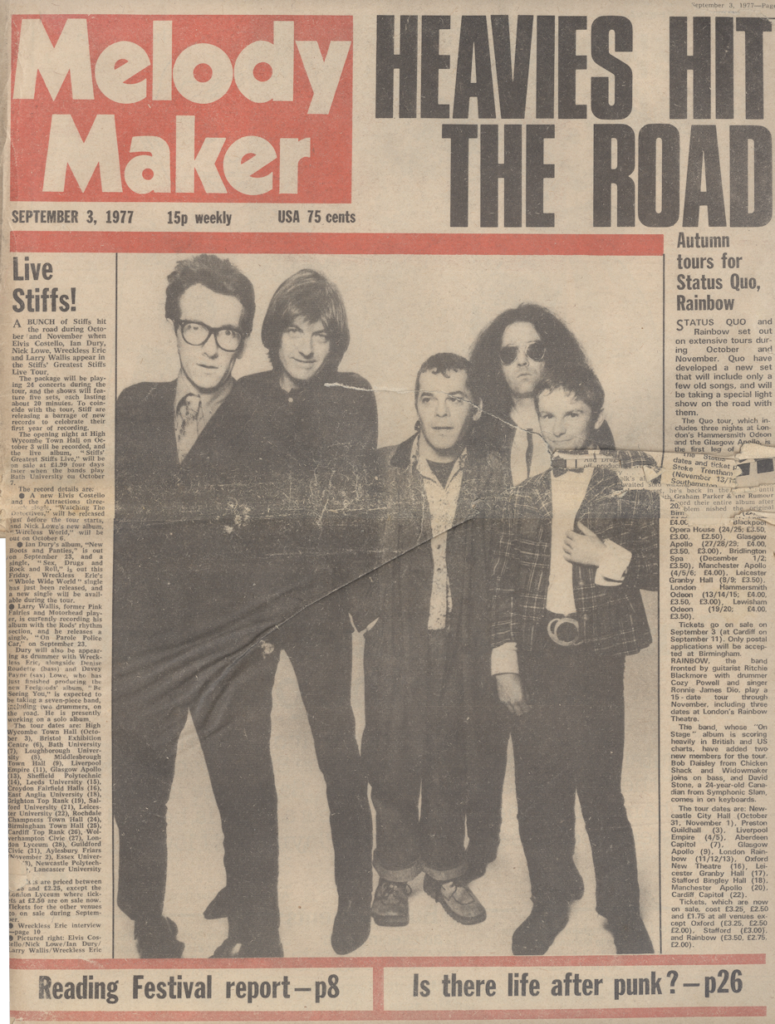
(Above) Elvis Costello exploded in the UK a fortnight before my arrival. The Live Stiffs package tour was roaming the UK with Stiff Records label-mates Nick Lowe (who produced My Aim Is True), Ian Dury (who would soon unleash his classic New Boots and Panties album a few weeks later), Wreckless Eric, and Larry Wallis.
(Below) Dury’s landmark “Sex & Drugs & Rock & Roll” 45 was MM’s Single of the Week in the next issue. With that single, he coined a phrase that’s become a permanent cultural fixture. (Further Below) MM’s Top UK & US charts for the week of Sept. 10.
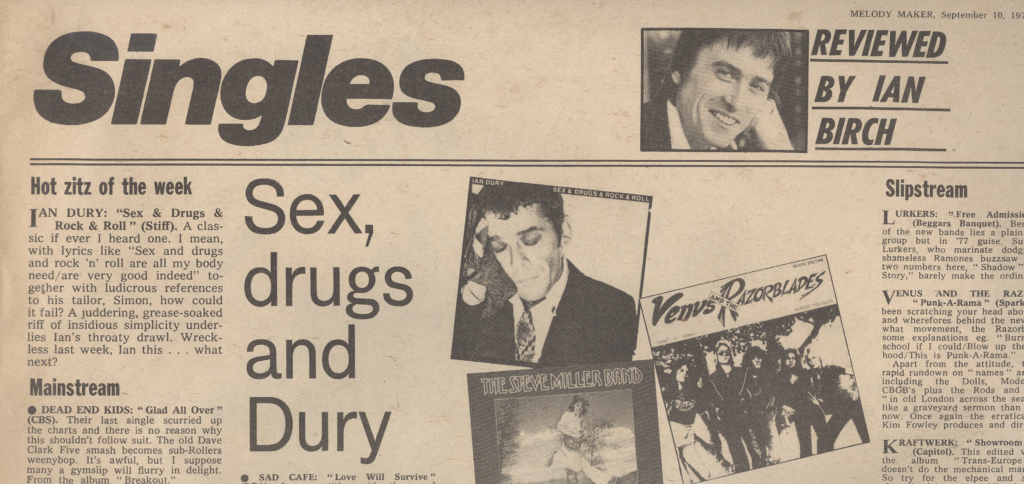
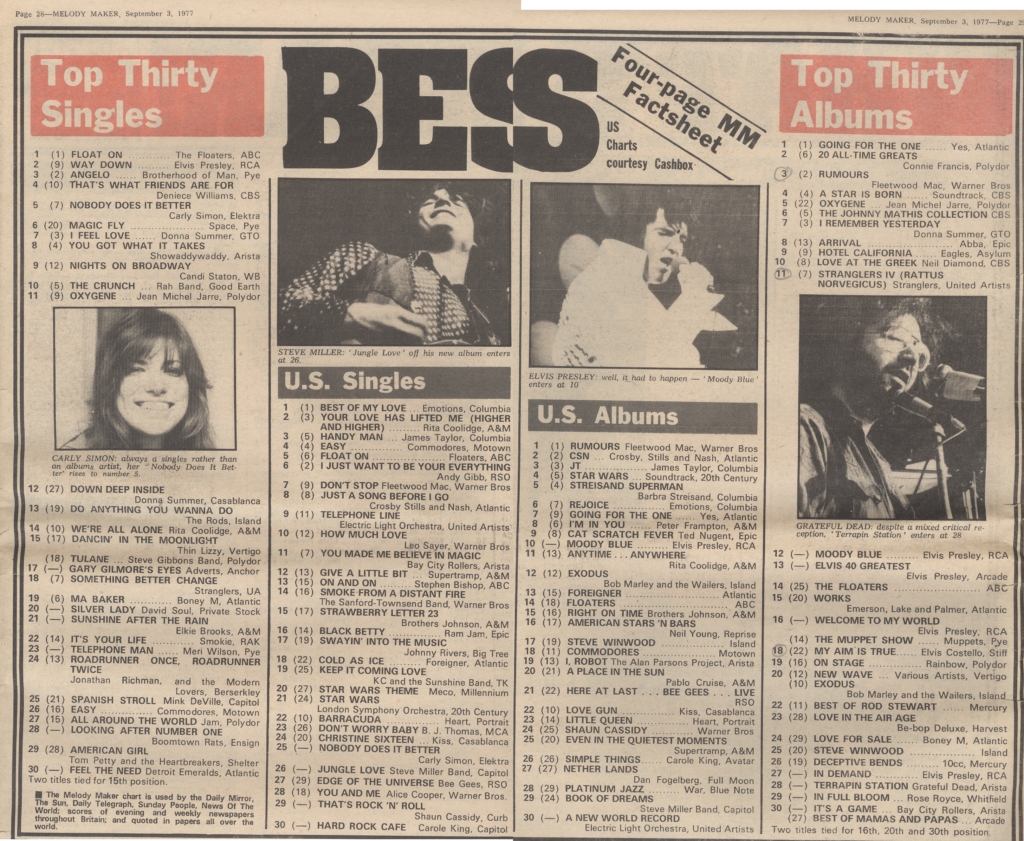
There were plenty of stories in the weeklies about Costello, particularly about him staging an illegal, amplified set on the street right outside London’s Hilton Hotel where CBS Records UK were holding a convention. He was arrested in the process which gave him national coverage.
While I saw mentions of this incident in the music press, I assumed that Costello had been this slow-building act that was now finally blowing up with his debut album, My Aim is True, and his brand-new, stand-alone single, “Watching the Detectives.”
It wasn’t until I read his autobiography, Unfaithful Music & Disappearing Ink, from 2015, that I realized that the CBS stunt wasn’t just a good piece of publicity, it had de facto launched him from relative obscurity to a star overnight. It was lost on me at the time that he’d only just come into the UK’s consciousness the week before I arrived.
So I discovered EC along with the rest of the country.
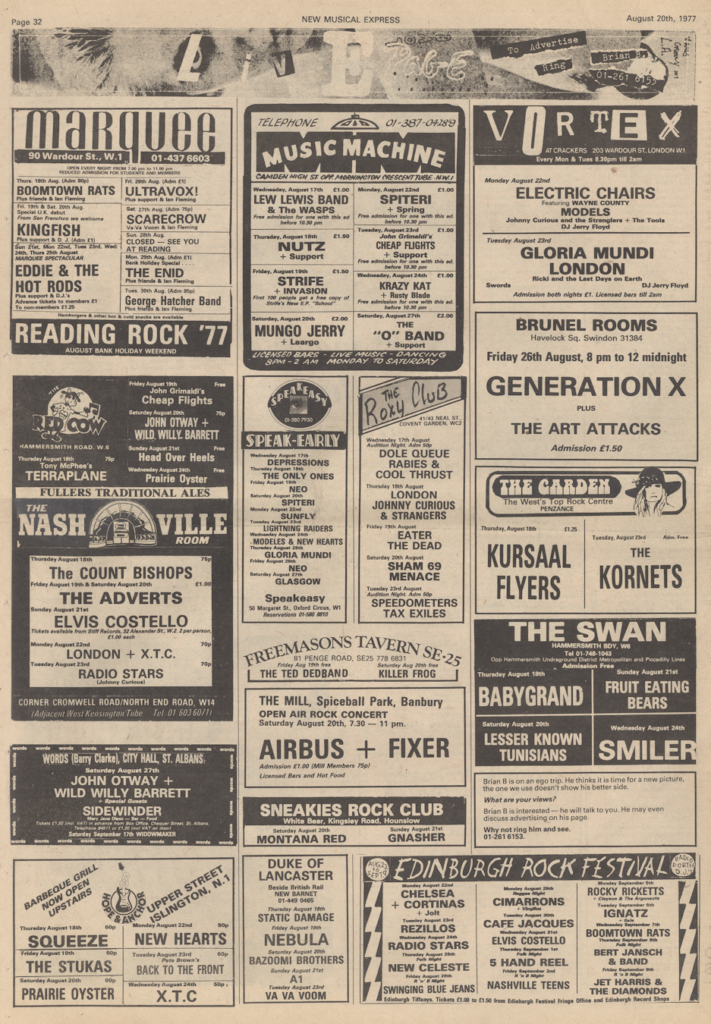 (NME, Above) London (and elsewhere) was exploding with live punk and new wave at the time. For the week of August 20, 1977, you could see Elvis Costello, XTC, The Boomtown Rats, Wayne County and the Electric Chairs, The Rezillos, Generation X, The Only Ones, The Adverts, John Otway and Wild Willy Barrett, Eddie and the Hot Rods, Squeeze, John Foxx’s Ultravox, and The Cortinas (a very personal fave: love that True Romances album). Let’s also throw in Eater and Sham 69. And a good chunk of all that was in London.
(NME, Above) London (and elsewhere) was exploding with live punk and new wave at the time. For the week of August 20, 1977, you could see Elvis Costello, XTC, The Boomtown Rats, Wayne County and the Electric Chairs, The Rezillos, Generation X, The Only Ones, The Adverts, John Otway and Wild Willy Barrett, Eddie and the Hot Rods, Squeeze, John Foxx’s Ultravox, and The Cortinas (a very personal fave: love that True Romances album). Let’s also throw in Eater and Sham 69. And a good chunk of all that was in London.
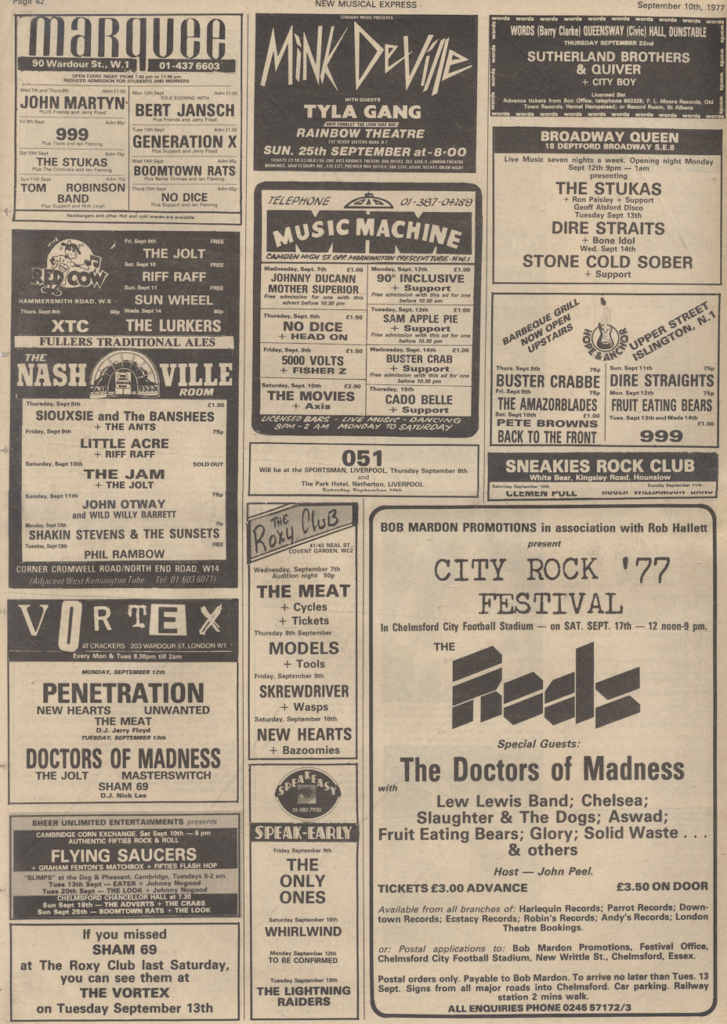
Three weeks later (Melody Maker, Sept. 10), your (mostly London) options expand to The Jam, Siouxsie and the Banshees (who are coming up next year in this series), Tom Robinson Band, 999 (also coming up), Mink DeVille, Penetration, and Slaughter and the Dogs as well as the terrific Aswad. On the non-punk front, note appearances by John Martyn, legend Burt Jansch, and two shows by the fledgling Dire Straits—or Dire Straights as they are (mis)spelled for their Hope & Anchor show. That festival lineup makes me uneasy as Fruit Eating Bears seem to be followed by Solid Waste …
I had seen My Aim Is True mentioned in the press and noticed it had entered the charts. I was thrilled to arrive at a Southampton record store just as an employee was putting it on over its sound system.
I’ll never forget hanging around there, listening to True in its entirety and being completely blown away. It was in the running for a record to buy. But I didn’t have a lot of cash with me so I bought most of my records near the end of the trip as I didn’t want to blow all my cash on tunes. For instance, I ended up buying a beautiful leather bomber jacket at a market in the north for £20. I wore it for years.
I still had yet to hear his new single and first chart hit, “Watching the Detectives.” I noticed that it wasn’t on the album and wasn’t sure why. Shortly thereafter, I heard it in a Woolies (or was it Boots?) up north in Cumbria. A teenage girl was working at the record bar, spinning the latest 45s, and threw that one on.
So, I knew right away that I loved Costello, an opinion that has never changed. He also turned out to be the first act from any of this new music that I saw live, in 1978. I have gone on to see him once per decade, in 1980, 1991, 2003, and 2011.
Moments later, I had my first taste of The Stranglers. Within 24 hours in the UK, I had already picked up a NME and immediately noticed that these Stranglers folks were in the Top 10 with their debut album (Rattus Norvegicus) and their new single (“Something Better Change”).
Just from their name, I knew they had to be *P*U*N*K* and found myself immediately interfacing with the album’s cover at the front of pretty much every record store I went into up and down the country. It was huge.
So, I found myself at that Boots’er’Woolies, with the turntable-tweaking teen twirling the tunes, when she put on a single that started with this great, staccato guitar riff. Then some cool, Doors-y keyboards came in before the song exploded.
This was definitely punk, albeit with a psychedelic sonic twist via the keyboards, and I Lurved the tune immediately as it went along. But who was this?
The moment it hit the chorus, I then knew it was The Stranglers’ current hit. Yup, add them to the “to be purchased” list.
There was also a fab compilation that was in the charts called New Wave. It was an interesting mix of UK & US (and Australian) punk, new wave, and some pre-punk, such as with the New York Dolls. It also featured hard-to-get singles by Patti Smith and Talking Heads as well as tracks by The Ramones, The Damned, Richard Hell and the Void-Oids, and more.
I heard that one in a record store too, and that was quite the introduction.
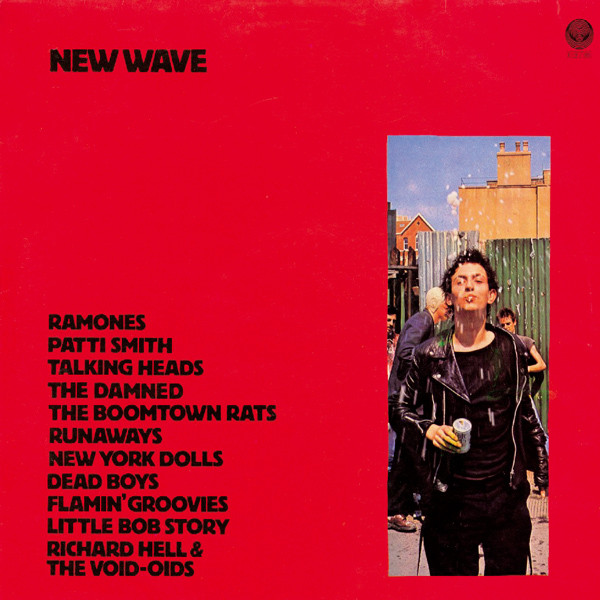
New Wave: an excellent early punk/new wave compilation, and a Top 20 LP hit while I was in the UK. While I did get to hear it playing in a record store there, I have long kicked myself for not picking up a copy of this while I was there.
As for my “punk” purchases, I ended up going for The Jam’s debut album, In the City, rendering me as an immediate megafan right through until their late ’82 demise. They were another act I discovered while I was there. Their debut album was in the charts along with their sophomore single, “All Around the World.” They had blown up and were all over the UK media.
I luckily got to the see them live in ’79 on the All Mod Cons tour in Toronto and have podcasted about that show in Episode 12.
My favourite track from The Jam’s debut album In the City: “Away From the Numbers.”
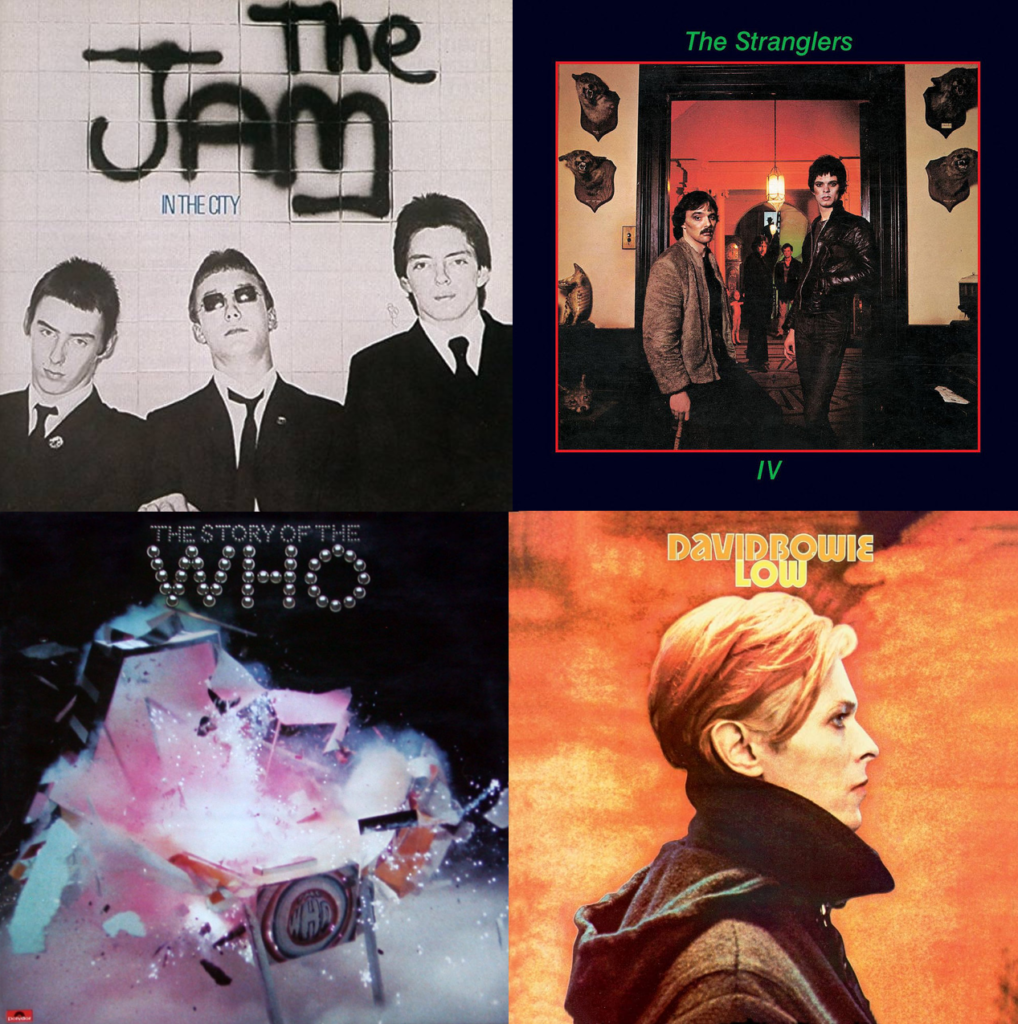
My LP purchases during (and shortly thereafter) the trip (clockwise from top left): The Jam In the City; The Stranglers Rattus Norvegicus; David Bowie Low; and The Story of The Who.
I also picked up Eddie and the Hot Rods great new single, “Do Anything You Wanna Do,” and The Boomtown Rats’ debut 45, “Looking After for No. 1.” It had been garnering raves in the press and was shooting up the charts, launching a 2+ year period in which they had a series of big UK hits singles and albums. I loved the Rats during this period and have written and podcasted in Episode about seeing them in 1980, when they became huge in Canada for that year.
However, I still had my other foot in the old wave and was also interested in other types of tunes, such as with Space’s “Magic Fly” which reflected my then-growing interest in electronic music (which took a pause shortly after this before my decidedly unpausing it in late ‘79/’80 and onwards.)
The Boomtoown Rats’ debut 45, the explosive “Lookin’ After No. 1,” took off and up the charts during the trip.
Also, as I knew I would be going to the UK, I had earmarked three records to pick up while I was there.
One of them was David Bowie’s Low. It had been released back in January and I was most curious to hear it. Its experimental and electronic nature intrigued me just as many other Bowie fans were turned off.
As I hadn’t heard it or picked it up yet, I decided that I would get a nice British pressing while I was there … which was a silly idea as I could have just picked it up here. Instead, I could have picked up that now rare New Wave compilation. Oh well, Low is my favourite Bowie album, I selected it as one of my Top 15 Favourite LPs, and the British packaging of the album is superior. It’s one I will never get tired of hearing and sure as hell played the dickens out of my original vinyl.
All’s well that ends well, as Willy said.
Another album I had been looking forward to picking up on this trip was a 1976 UK-only double Who compilation that I knew of via the UK press: The Story of the Who. Then as now, I love the 1965-75 era Who and had some of their albums and singles, but there were a few my sister owned that I didn’t have. I thought this would be a great gap-filling purchase for my ever-growing record collection, especially regarding some of the early tracks.
Looking back on it now, it’s an enjoyable and interesting compilation but certainly not definitive. However, I loved it at the time along with its gatefold packaging and wonderful inner sleeve book. I used to pour over it while listening to the album.
But in general, this trip actually tripped a switch for me big time, as my tastes started rapidly changing from what I had been listening to in the mid-70s.

(Above) NME September 10, 1977, with Thin Lizzy’s Phil Lynott on the cover. (Below) The NME UK Top 30 for that week. Elvis has left the building but flooded the charts.
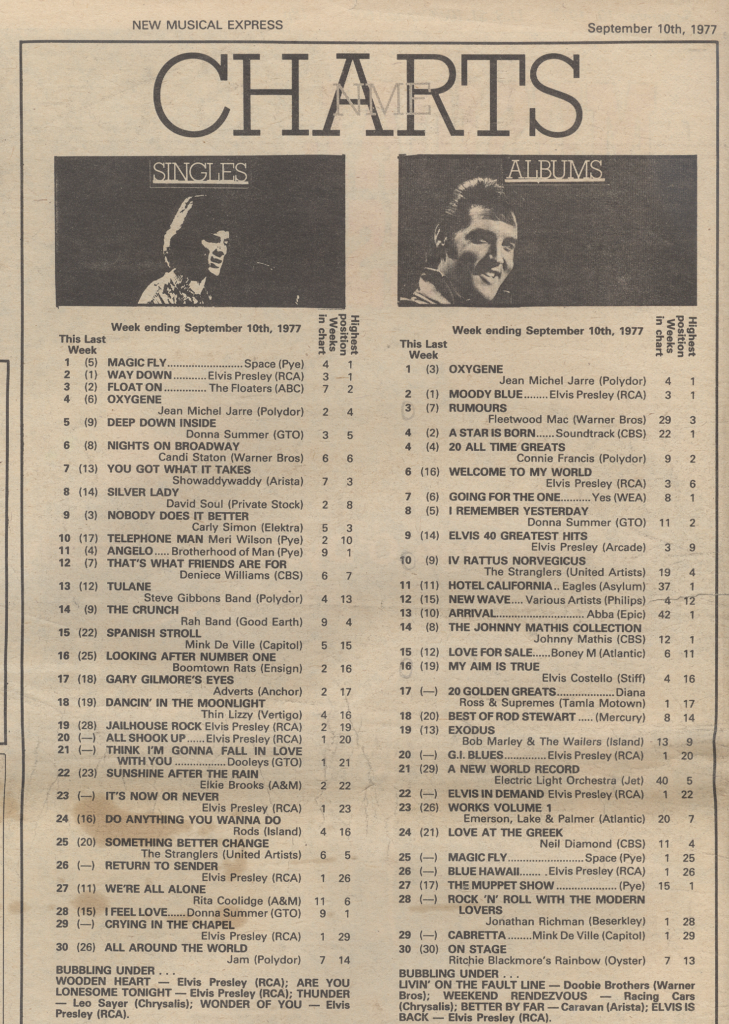
I have written in the Bob Seger entry about how that period, say mid-‘74-to-mid-’77, was a strange era for me musically. During that time, while I still of course had my interests in alternative music, another part of my tastes veered more toward the rock mainstream than usual. While there is plenty of great and big rock acts from the time that I loved then as now, from the 1975 model of Fleetwood Mac through Led Zeppelin, I got into a bunch of other acts that I liked just during this period that I have never really cared for since: the Eagles, Queen, ELO, and Genesis to name a few.
Genesis especially (although I do love Peter Gabriel’s solo work).
The third pre-targeted purchase was their Spot the Pigeon EP which had been released in the UK earlier in the year.
As the band were best known for long, intricate prog suites, this 3-track EP sporting two unabashedly poppy songs on the A side (“Match of the Day” and “Pigeons”) was a curio to say the least.
And in going back and listening to it, I had a realization: punk indirectly had a hand in creating the ‘80s-pop-stars version of Genesis!
No, really.
It goes like this: Punk has started getting plenty of ink in the UK weeklies by mid-76, even before any recordings from the scene had even been issued. It then exploded into the British consciousness via the Sex Pistols’ Bill Grundy interview in December 1976. It quickly became a ground-shaking critical, cultural, and—rather importantly—commercial success almost immediately.
Overnight, many old school ideas and musical presuppositions were tossed out the window, like a fetid diaper, with prog being identified as one of the arch-enemies.
Suddenly, a host of musical darlings in the UK became instantly passé in a way that they weren’t almost anywhere else around the globe at that time. For a band like Genesis and their peers—with sizeable European audiences and a growing one across the ocean but where England was their then-key market and bread and butter—this sea-change/backlash was an unwanted and unexpected front-door nuisance.
As with many other UK-as-main-market acts of the time who made stylistic changes or slimmed down the excess and length of their tunes, Genesis responded by issuing that most un-prog-type of formats: an EP. “Pigeons” even features a one-note lead riff, and Collins bloody well says “Shit.” Oooh, you buggers!
“Pigeons” by Genesis from their 1977 Spot the Pigeon EP. A clairvoyant, streamlined moment for them, three years early in the wake of punk: a one chord guitar riff and Phil Collins saying “Shit.” What the bloody, buggery, bollocks …
By its nature, EPs tend to feature shorter songs for maximum tracks, which was the case with the two A-side numbers. And in re-listening to them, it struck me that this was essentially a dry run for the big-pop-hits-Genesis that arrived at the start of the 80s.
I find it fascinating when artists put out these out-of-character-type records that end up being harbingers of their style to come. Artists as diverse as folk-era Bob Dylan releasing 1962’s rockin’ “Mixed Up Confusion” 45, complete with a backing band, or the austere, arty, post-punky Human League releasing their 1979 “I Don’t Depend on You” disco single with two female backing vocals as The Men, presaging their pop sound and six-person lineup of ’81 by two years, are two other examples of artists having a clairvoyant moment.
This Genesis EP is another example.
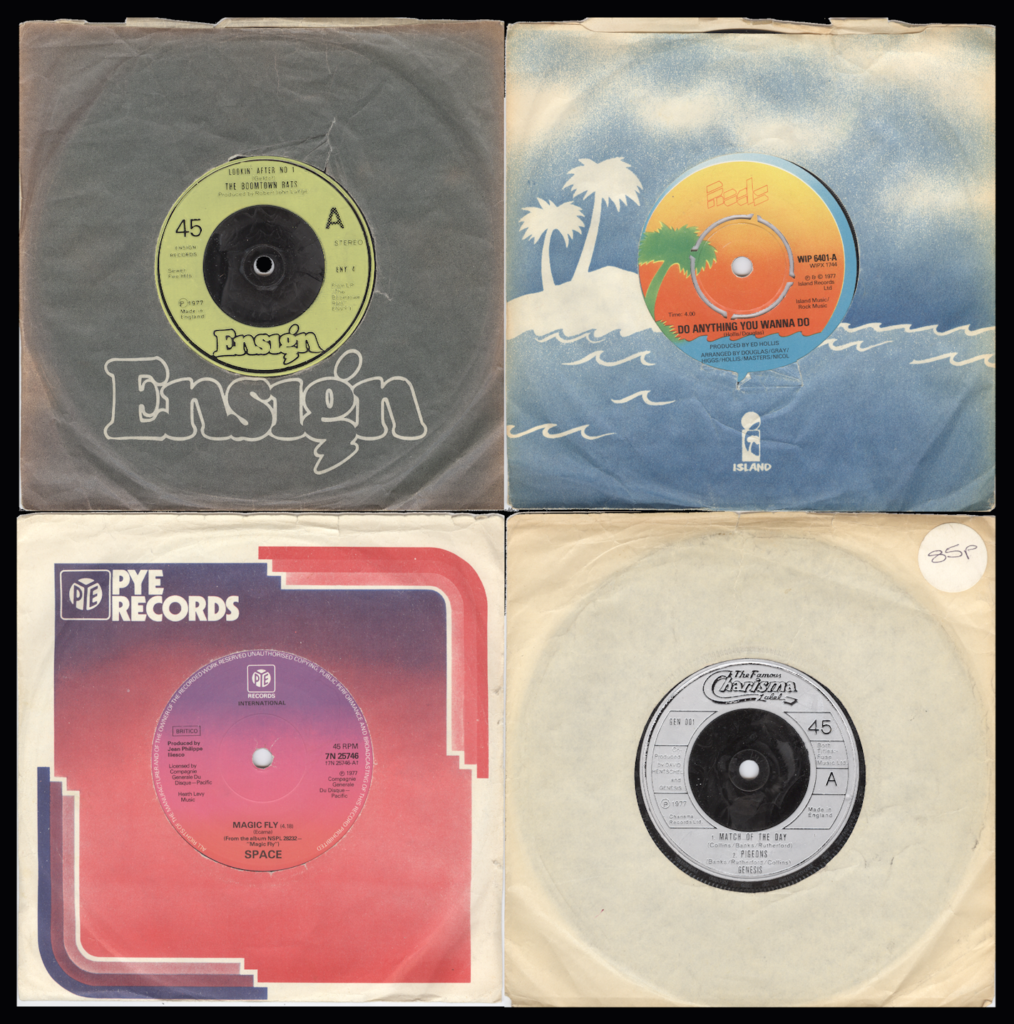
My UK 45 purchases (Clockwise from top left): “Lookin’ After No. 1” The Boomtown Rats; “Do Anything You Wanna Do” Eddie and the Hot Rods; Spot the Pigeon EP Genesis; and “Magic Fly” Space. (Scans by VA)
One other prog-related memory from this trip was tuning in hourly to the airplane’s looping “rock channel” to hear this long track that transfixed me. It was a good 10 minutes, started with classical-esque piano, incorporated a laughing madman, and then segued into the core tune featuring a vibrant female vocalist.
I wondered for years who the group and what the song was. The mystery was finally solved circa 1981 when someone played it on the local college station, CHRW. Turns out it was UK proggy/folk/classical combo Renaissance and their epic “A Trip to the Fair,” from 1975.
I actually got to see Renaissance in 2010 but, sadly, there was no “Trip to the Fair.”
A recurring prog moment on the flight there and back: Renaissance’s “Trip to the Fair” (1975).
Alas, all good things must come to an end, though, and back we flew.
Or tried to.
The day we were scheduled to fly back, the UK airline industry went on strike, with departing planes greatly reduced. We ended up spending 24 hours at Gatwick airport, taking turns trying to catch some zzzz’s on the airport’s lounge seats.
Luckily the airport had a book store where I purchased an oversized hardcover title on The Beatles and their history. I read the whole thing over the course of the day we were there. (’77 was a particularly Beatles summer for me as I finally bought a copy of Sgt. Pepper for its 10th anniversary amid repeated spins of Live at the Hollywood Bowl, which had been released in May.)
We were beyond-relieved to finally be boarding the plane, although coming back to boring old London, Ontario after having personally experienced this exciting musical movement was such a downer. Back to nothing but Debby Boone, Shaun Cassidy, and corporate MOR rock.
What a brutal comedown.
However, I had seen the future, as it were, and was excited knowing that punk would soon be exploding over here on this side of the Atlantic in short order, just like it had in the UK.
Whoopsy-daisy on that one!
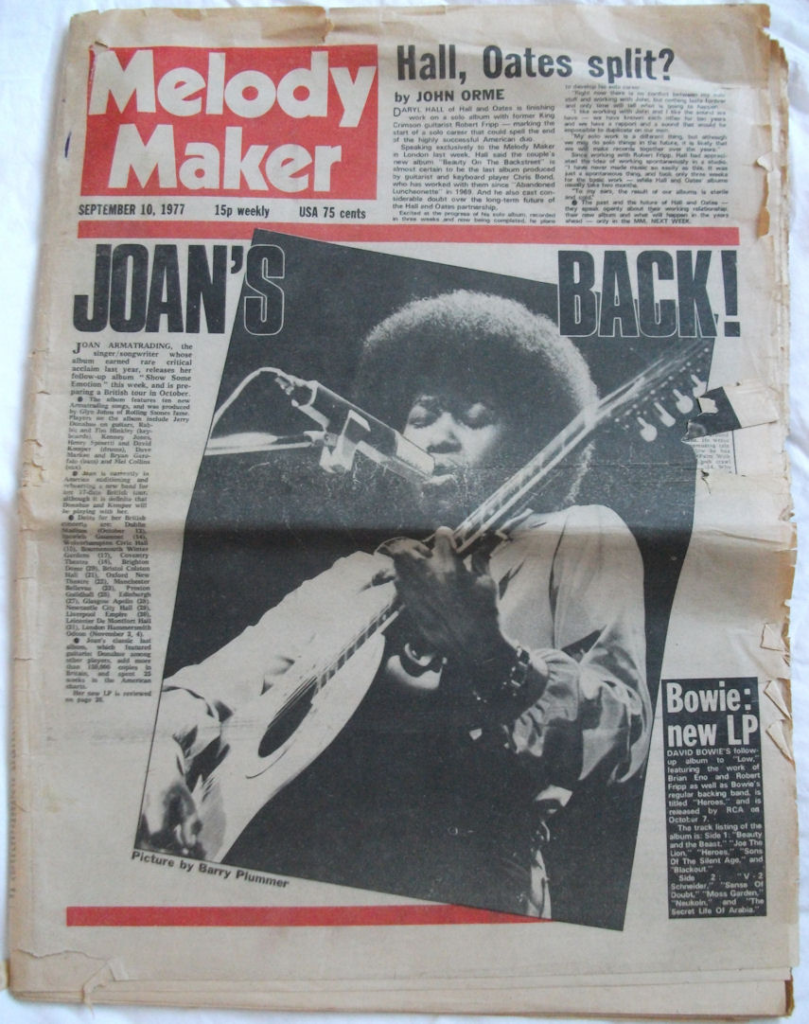
(Above) Melody Maker September 10, 1977.
I hadn’t yet processed just how claustrophobically, regressively conservative music stations and listeners were in North America at that time. This whole upheaval was sooooo exciting and fresh, and the records were not only gorgeously primal, but many had killer hooks and melodies, a point that frequently gets left out about punk.
It really wasn’t until Nirvana hit at the end of 1991 that North America finally had a raw, unpolished musical movement breakthrough on a mass commercial level, something I thought would never truly happen here by that point. I had been working in record retail for over 6 years when the Nevermind bomb hit and, O!, how I loved watching hair metal, boy bands, and sugar-coma-inducing industry pop absolutely hit the skids pronto, even if just for a few years.
Meanwhile, the Sex Pistols’ Never Mind the Bollocks finally went platinum on this side of the pond around that time, with it being a slow burn infiltration here, rather than the seismic hit it was overseas.
But back to ’77: I picked up The Stranglers’ Rattus Norvegicus shortly after returning. (33 years later, I got to see Hugh Cornwell perform Rattus in its entirety to a packed Zaphod’s in Ottawa with Blondie’s Clem Burke on drums. A very fun night.)
Even better, Eddie and the Hot Rods actually came here to London, Ontario, playing a few nights at Fryfogle’s in November, kicking off the punk rock scene here in the forest city. I was unfortunately too young to attend, but did get to meet and talk to the band at Records on Wheels. Here’s my copy of their debut album, Teenage Depression, autographed by lead singer Barry Masters.
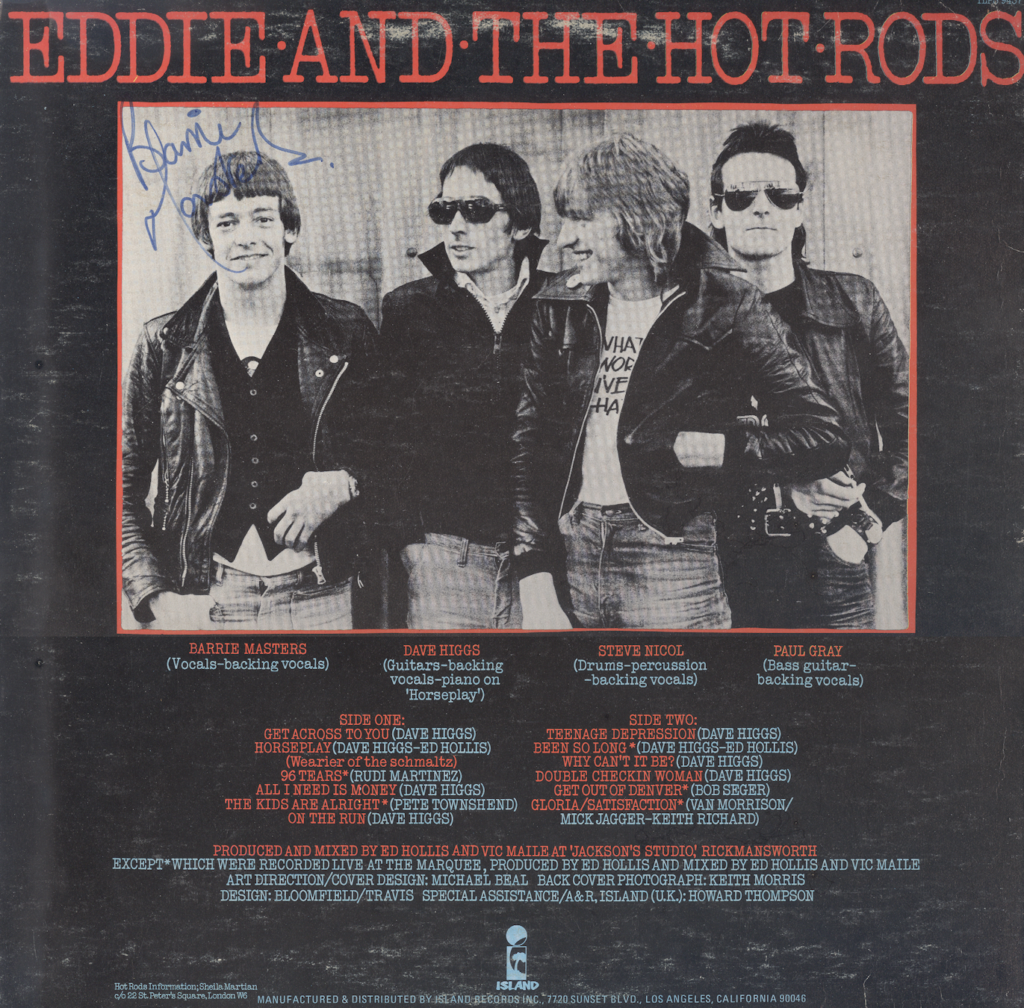
The next month, the Demics made their debut, opening the floodgates for punk and all types of alternative music in the Forest City in the years and decades that followed.
In the months ahead after my trip, my focus shifted further and more pointedly toward punk and new wave with my purchases of albums by The Sex Pistols, Ramones, Vibrators, Blondie, The Clash, and many more.
The following spring, I saw my second official, full-length live show: Bob Seger at the London Gardens. But by this point, I was starting to think, listen, and expect differently. I have podcasted and written about how it was my final “mid-70s” moment.
A corner had turned, delivering me unto several of some of the most musically exciting, liberating, fascinating, and experimental years I have ever experienced.
Bring it on!
Next on Stage -> I jump a bit more into the future with The Stray Cats at Alumni Hall here in London on March 26, 1983. Technically this should have been Episode 16 but, as with this 1977 entry, this show was initially meant to be included with the upcoming compilation episode.
I don’t have a ton of memories about this show, but every time I have posted about it on Facebook, there are floods of responses from people, so clearly this was a concert that is in the hearts of many who were there.
Luckily, MLIC podcast regular Phil Robinson as well as Noëlle from the Police Picnic ’83 episode (no. 27) both have lots of great memories from the night.
Tune in for stage dancing, artistic representations, Britt Ekland sightings, and what was the unforgettable message that Brian Setzer imparted to Noëlle backstage?
Following that, the much-delayed UB40 episode with Phil Robinson and Skye Sylvain will finally arrive.
Episode 032 (Concert no. 025) Rock This Town: The Stray Cats with The Bopcats, UWO, London Ontario, March 26, 1983
Episode 033 (Concert no. 026) So Here I Am: UB40, Centennial Hall, London, Ontario, March 7, 1984; Alumni Hall, UWO, London, Ontario, March 14, 1985
© 2023 Various Artists

